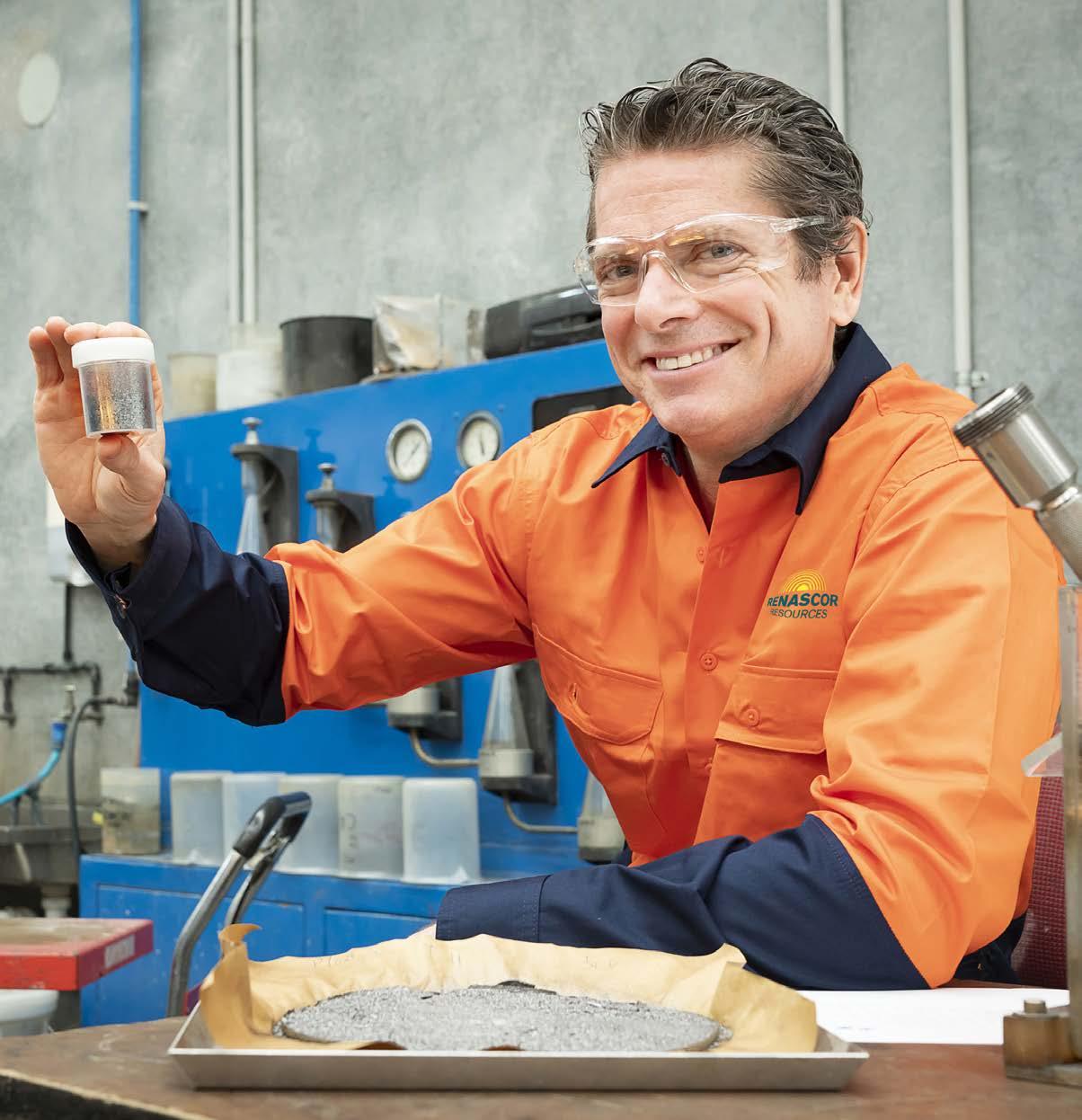

AUSTRALIA’S BRIGHT COPPER FUTURE NEW SHARK IN TOWN WHY GOLD CAN SHINE BRIGHTER IN 2023 HOW PILBARA MINERALS BUILT A LITHIUM EMPIRE VOLUME 17 NUMBER 2 | 2 023 Australian Resources & Investment GRAPHITE’S TIME TO SHINE Charging up decarbonisation
United. Inspired.
The world needs metals and minerals for the energy transition and we need cities that can cope with a growing population in a sustainable way. To succeed we need to speed up the shift towards a more sustainable mining and construction industry. We at Epiroc accelerate this transformation


– 4 –
See how we accelerate the transformation
TOM
Tom.Parker@primecreative.com.au

For the world’s decarbonisation to occur, and for global net-zero goals to be met, it is key that new mines are developed as much as brownfield operations are extended. This will require contributions from a range of commodities in countries across the world. As an established and stable mining jurisdiction, Australia has the opportunity to be a frontrunner not only in exporting minerals to the world but by also being a pioneer of change.
In its 2023 Tracking the Trends report, Deloitte considers three key themes that will underpin the resources sector this year and beyond.
These include: the strategic advantages available through natural capital; mining’s role in a circular economy; and the need to drive down embodied carbon in mining.
Investors and policymakers are treating the resources industry differently today than in the past, and this is requiring a step change in thinking for many mining companies. This is particularly so in Australian mining, where companies are no longer getting away with ‘greenwashing’ or errant reporting.
As investors pry for greater transparency, governments are calling for greater emissions reduction.
The Australian resources industry is having to change the way it does things, but with change comes opportunity and in reconfiguring their operations, companies can unlock value in new, innovative ways.
In the April edition of Australian Resources & Investment, we shine a light on two commodities critical to the world’s energy transition: graphite and copper.
Renascor Resources believes “graphite is the next lithium” and with supply shortages looming amid rising demand, prices could climb to new highs in the years to come.
We sit down with Renascor managing director David Christensen to talk about the company’s progress towards becoming a near-term graphite producer, while we also feature International Graphite, which is developing its Collie downstream plant and Springdale graphite project in WA.
The world is going to need all the copper it can get in the future, and as a growing copper miner, Aeris Resources has an important role to play in the years ahead. We chat to Aeris executive chair André Labuschagne about how the company looks to uplift its suite of projects across Australia. Elsewhere, we highlight the success of Australia’s soon-to-be halloysite-kaolin producer, Andromeda Metals, contemplate what lithium prices will look like in 2023, and chat to emerging ASX-listed gold companies Flynn Gold and Adelong Gold. Happy reading.
CHIEF EXECUTIVE OFFICER
JOHN MURPHY
CHIEF OPERATING OFFICER CHRISTINE CLANCY
EDITOR
TOM PARKER
Email: tom.parker@primecreative.com.au
MANAGING EDITOR
PAUL HAYES
Tel: (03) 9690 8766
Email: paul.hayes@primecreative.com.au
CLIENT SUCCESS MANAGER
JUSTINE NARDONE
Tel: (03) 9690 8766
Email: justine.nardone@primecreative.com.au
SALES MANAGER JONATHAN DUCKETT

Mob: 0498 091 027
Email: jonathan.duckett@primecreative.com.au
BUSINESS DEVELOPMENT MANAGER DAVID GOLDBERG Mob: 0434 792 225 Email: david.goldberg@primecreative.com.au
SALES ADMINISTRATOR EMMA JAMES Tel: (02) 9439 7227 Mob: 0414 217 190 Email: emma.james@primecreative.com.au
DESIGN PRODUCTION MANAGER MICHELLE WESTON michelle.weston@primecreative.com.au
ART DIRECTOR BLAKE STOREY blake.storey@primecreative.com.au
GRAPHIC DESIGNERS KERRY PERT, LOUIS ROMERO
FRONT COVER Renascor Resources managing director David Christensen at ALS Metallurgy.
Image: Renascor Resources
SUBSCRIPTION RATES Australia (surface mail) $120.00 (incl GST) Overseas A$149.00
For subscriptions enquiries please contact (03) 9690 8766 subscriptions@primecreative.com.au
PRIME CREATIVE MEDIA
379 Docklands DR, Docklands, VIC 3008, Australia www.primecreative.com.au
© Copyright Prime Creative Media, 2021 All rights reserved. No part of the publication may be reproduced or copied in any form or by any means without the written permission of the publisher.
Tom Parker Editor
PRINTED BY MANARK PRINTING 28 Dingley Ave Dandenong VIC 3175 Ph: (03) 9794 8337 Published 12 issues a year
WWW.AUSTRALIANRESOURCESANDINVESTMENT.COM.AU
– 3 –AUSTRALIAN RESOURCES & INVESTMENT
PARKER
COMMENT
Australia sets itself up Australia has the opportunity to be a key player in supplying the world’s green energy transition across a range of commodities.
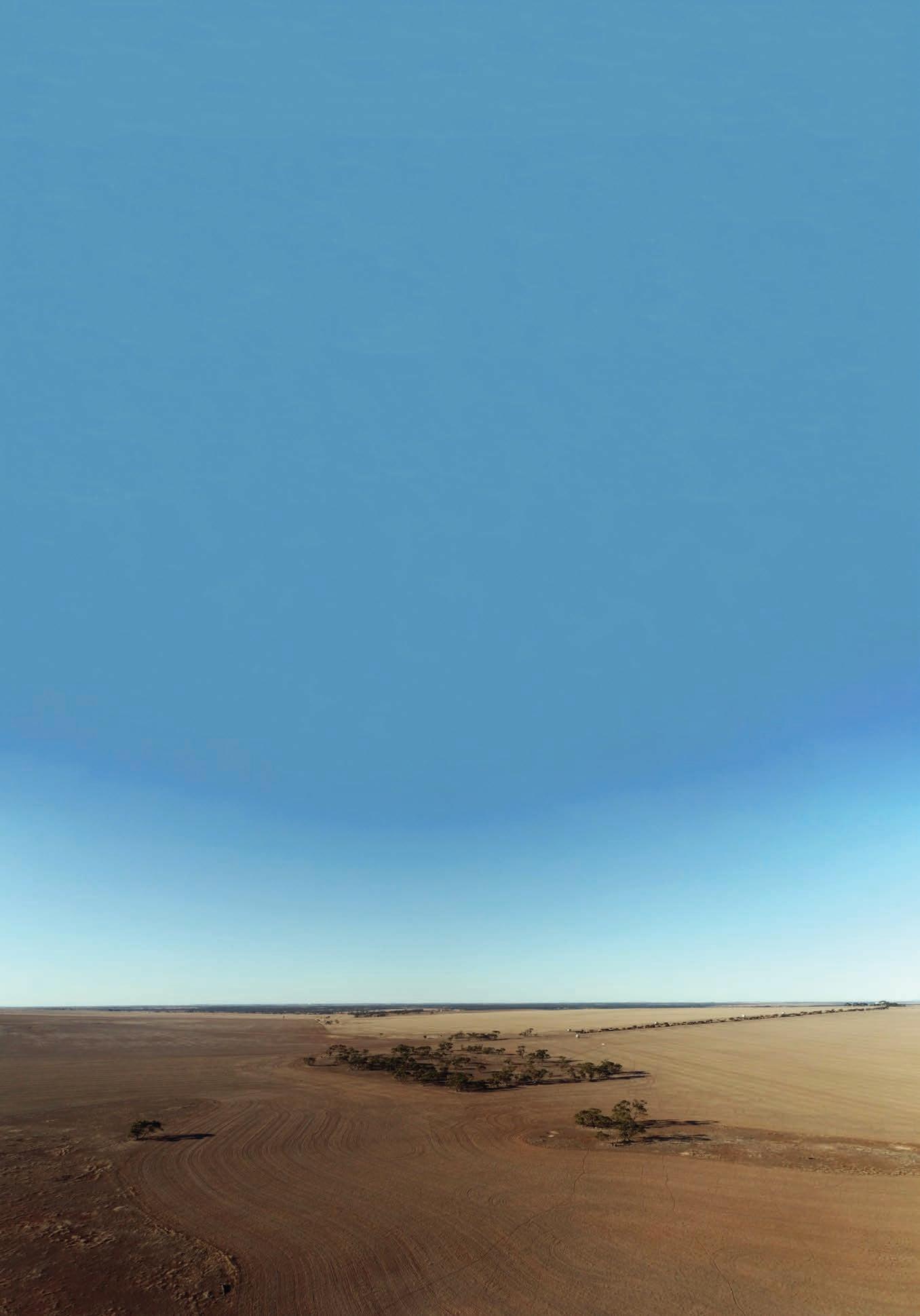
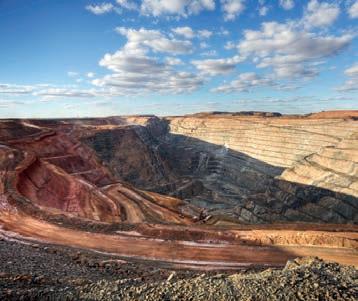

THE FEATHERSTONE REPORT 6 Why gold can shine brighter in 2023 FEATURED 10 A nalysis with Regina Meani 12 ‘ Graphite is the next lithium’ 16 Australia’s bright copper future COPPER 18 Cloncurry: Australia’s key copper district LITHIUM 20 Why 2023 is a pivotal year for lithium prices HALLOYSITE-KAOLIN 24 N ew shark in town GOLD 26 A near-term gold producer steeped in history 28 A n early-mover in north-east Tasmania ESG 30 New era for tailings management DECISION-MAKER 34 H ow Pilbara Minerals built a lithium empire 36 Elevating Mincor RARE EARTHS 38 A rare earths project backed by centuries of experience INDUSTRY INSIGHT 40 Mine of the future MINING SERVICES 44 Instigating mining’s new frontier 46 An evolution like never before FOLLOW THE LEADERS 48 The latest executive movements in the resources sector EVENTS 50 What’s happening in the resources industry?
CONTENTS 18 40 – 4 –
IN THIS ISSUE
ASX: FG1
TASMANIA
• 10 granted Exploration Licences
• 1,465 km2, 100% Flynn Gold
• Northeast Tasmania - under-explored extension of Victorian goldfields

• Western Tasmania – Henty Zinc/Lead/Silver project with multiple drill targets

OUTSTANDING GOLD RESULTS AT GOLDEN RIDGE PROJECT, NE TASMANIA
• Gold anomalism over 8km strike evidenced by latest drilling and historical workings
• Significant gold mineralisation recorded in drilling at Trafalgar, Brilliant, Link Zone and Kensington Prospects
• High-grade gold mineralisation (up to 152.5g/t Au) in multiple vein zones over an open strike length exceeding 200m intersected at Trafalgar
WESTERN AUSTRALIA
• 27 tenements and applications
• 1,260 km2, 100% Flynn Gold
• Pilbara – holdings close to significant gold and lithium deposits
• Yilgarn – holdings close to world class lithium and nickel deposits
Li Au Lithium 7.0 Gold 196.966 3 79 www.flynngold.com.au Quartz-sulphide (pyrite-arsenopyrite-pyrrhotite-galena-sphalerite) vein in TFDD005 at 121m (0.7m @ 152.5g/t Au)
WHY GOLD CAN SHINE BRIGHTER IN 2023
BY TONY FEATHERSTONE
Currency-hedged Exchange Traded Funds limit risk for exposure to gold bullion.
Prominent investment commentator Mohamed A. El-Erian recently outlined three possible scenarios as central banks wage war on inflation.
The first was “orderly disinflation”. Inflation in the US retreats steadily towards the Federal Reserve’s 2 per cent target without hurting economic growth or jobs. El-Erian puts the probability of this scenario at 25 per cent.
The second scenario was “sticky inflation”. Rapid increases in interest rates would drive inflation lower before it got stuck at 3–4 per cent. Central banks would have to choose between further rate rises that could crush the economy, or persistently higher inflation. The probability of this scenario – the likeliest of the three – was 50 per cent.
The third scenario was “U inflation”. After falling this year, inflation would rise next year as China’s economy strengthened and the US labour market remained tight. El-Erian, chief economic adviser at Allianz, said this probability was 25 per cent.

El-Erian’s view on inflation is fascinating for market watchers, including those interested in gold. The precious metal’s reputation as a hedge against rising inflation is well known, although rarely as clear-cut as many investors believe.
El-Erian’s base case for inflation aligns with my own view that inflation will prove harder to bring down than financial markets expect.
During the early stages of COVID, I argued that higher inflation was not just a transitory
response to supply-chain bottlenecks, but it was also a response to inflationary forces that had been building for years.
Two of those forces are deglobalisation and an ageing global population. Rising geopolitical risks – notably Russia’s invasion of Ukraine and fears that China could invade Taiwan this decade – have encouraged Western companies to “reshore” more aspects of their supply chains. That is, to favour localisation over globalisation.
Deglobalisation makes some sense from a geopolitical perspective. Relying on
manufacturing or commodity supply from autocratic nations has become a bigger gamble in recent years. Moving production back to democracies is less risky.
But deglobalisation is inflationary. It costs more to make goods in the US than it does in China.
The essence of globalisation is about producing goods where they are cheapest to supply: deglobalisation turns that logic on this head.
The ageing population will be another contributor to persistent higher inflation, even
– 6 –FEATHERSTONE REPORT
THE Featherstone REPORT
When the US dollar falls, the price of gold tends to rise, and vice versa.
though markets debate this phenomena far less than they should. In theory, an ageing population means fewer people in the full-time workforce and adds to labour-market tightness. That, in turn, adds to higher wage pressure and inflation.
Like many correlations, the relationship between an ageing population and higher structural inflation is not straightforward. People these days tend to work longer, retire later and take on part-time jobs in retirement. But an ageing population will surely weigh on growth in labour supply in coming years.
PROSPECTS FOR GOLD
El-Erin’s central scenario suggests falling inflation this year as interest rate rises slow consumer demand. This supports gold as falling inflation enables central banks to slow the pace of rate rises and cut rates in 2024.
Expectations of falling interest rates will lead to a weakening of the US dollar. The inverse relationship between the tradeweighted US dollar and the price of gold is well-established. When the US dollar falls, the price of gold tends to rise, and vice versa.
A falling US dollar increases the value of other countries’ currencies, which increases demand for gold and other commodities. Also, as the value of the US dollar falls, investors look for alternative investments as a store of value. Gold is a key store of value.
Of course, the price of gold is affected by factors beyond the US dollar. Gold supply and demand are critical, as are yield differentials. When interest rates fall, yields fall with them, making gold (which doesn’t provide yield) relatively more attractive.
My base case is for a gradual fall in the trade-weighted US dollar index this year, amid
expectations that inflation has peaked and that interest rates have almost peaked.
After rallying for much of 2022, the US dollar index began to retreat in November. The market started to price in “peak inflation” and a slower pace of rate hikes. As the US dollar fell late last year, the US-dollar gold price rallied in early-2023.
The US Federal Reserve has lifted rates more aggressively than other central banks, and in March 2023 signalled that more rate rises are likely.
That pushed the US dollar index higher, but it also suggests expectations for US rate rises are getting much closer to their peak. If rates keep rising, economies will be crushed.
Although inflation will fall this year, I agree with El-Erin that inflation rates will settle at 3–4 per cent for longer. For most of the last decade, inflation was below 2 per cent and Australians enjoyed record-low interest rates.
A higher base level for inflation will support
gold’s status as an inflation hedge. Also, as economic and market uncertainty remains high, demand for gold will be well supported this year.
The result is an unusual situation of a gradually retreating US dollar in the second half of 2023 supporting a higher gold price in the short term; and higher-than-usual inflation and market volatility supporting gold as an inflation hedge and store of value in the medium term.

To be clear, I’m not suggesting a large rally in the gold price this year. Much could go wrong in the fight against inflation, requiring more rate rises than markets currently expect and higher rates for longer. That would help the US dollar and hinder gold.
But the case to increase portfolio allocations in gold is strengthening. I’ve long argued that most investors should have at least 5 per cent of their portfolio in gold, and modestly increase or decrease that allocation
– 7 –AUSTRALIAN RESOURCES & INVESTMENT
A higher base level for inflation will support gold’s status as an inflation hedge. Also, as economic and market uncertainty remains high, demand for gold will be well supported this year.
There are many factors that dictate the gold price, but the overarching gold sentiment is positive for 2023.
Tony Featherstone is a former managing editor of BRW, Shares and Personal Investor magazines. The information in this article should not be considered personal advice. It has been prepared without considering your objectives, financial situation or needs. Before acting on information in this article consider its appropriateness and accuracy, regarding your objectives, financial situation and needs. Do further research of your own and/or seek personal financial advice from a licensed adviser before making any financial or investment decisions based on this article. All prices and analysis at January 11.
according to market conditions. Current conditions favour a slightly higher portfolio allocation to gold.
ETFS FOR GOLD EXPOSURE
Investors have three main choices for gold exposure: buy gold equities; buy Exchange Traded Funds (ETFs) that invest in gold bullion; or buy gold bullion directly.

I prefer ETFs that provide exposure to gold bullion over buying gold equities directly. Well-chosen gold equities can be a great investment and generate higher returns than gold bullion (due to additional gains from the company).
But gold equities come with company and equity-market risk. The price of gold might rise, but gold equities can still fall sharply if global equity markets tumble, amid inflation and interest-rate uncertainty.
Gold ETFs provide pure exposure to gold bullion. It’s more convenient to get that
exposure via a gold ETF on the ASX that is bought and sold like a share, compared to owning, handling and storing gold bullion directly (which some still prefer).
Investors who believe gold is heading higher this year – and that gold ETFs are the best tool for gold-bullion exposure – face another key decision: currency protection. Should investors hedge their exposure against movements in the AUD/USD exchange rate?
The short answer: yes. The case for Australian investors, generally, to hedge their international investments this year, is rising.
If the Australian dollar rises 5 per cent against the Greenback, the value of your offshore US-dollar investments would fall by 5 per cent when converted into your local currency, all things being equal. In theory, the reverse is also true if the Australia dollar falls against the Greenback.
Australian investors who have US-dollardenominated investments, and believe the Australian dollar will strengthen this year as the US dollar gradually weakens, should consider hedging their gold-bullion exposure.
ETF issuer BetaShares offers a currencyhedged Gold Bullion ETF (ASX:QAU) for investors who want to eliminate currency risk in their gold exposure and seek cost-effective exposure to the gold bullion price via the ASX.
VanEck Australia has an interesting new gold ETF: the VanEck Gold Bullion ETF (ASX: NUGG). The ETF provides exposure to Australian-sourced gold, has low fees and can be redeemed for physical gold. NUGG is unhedged.
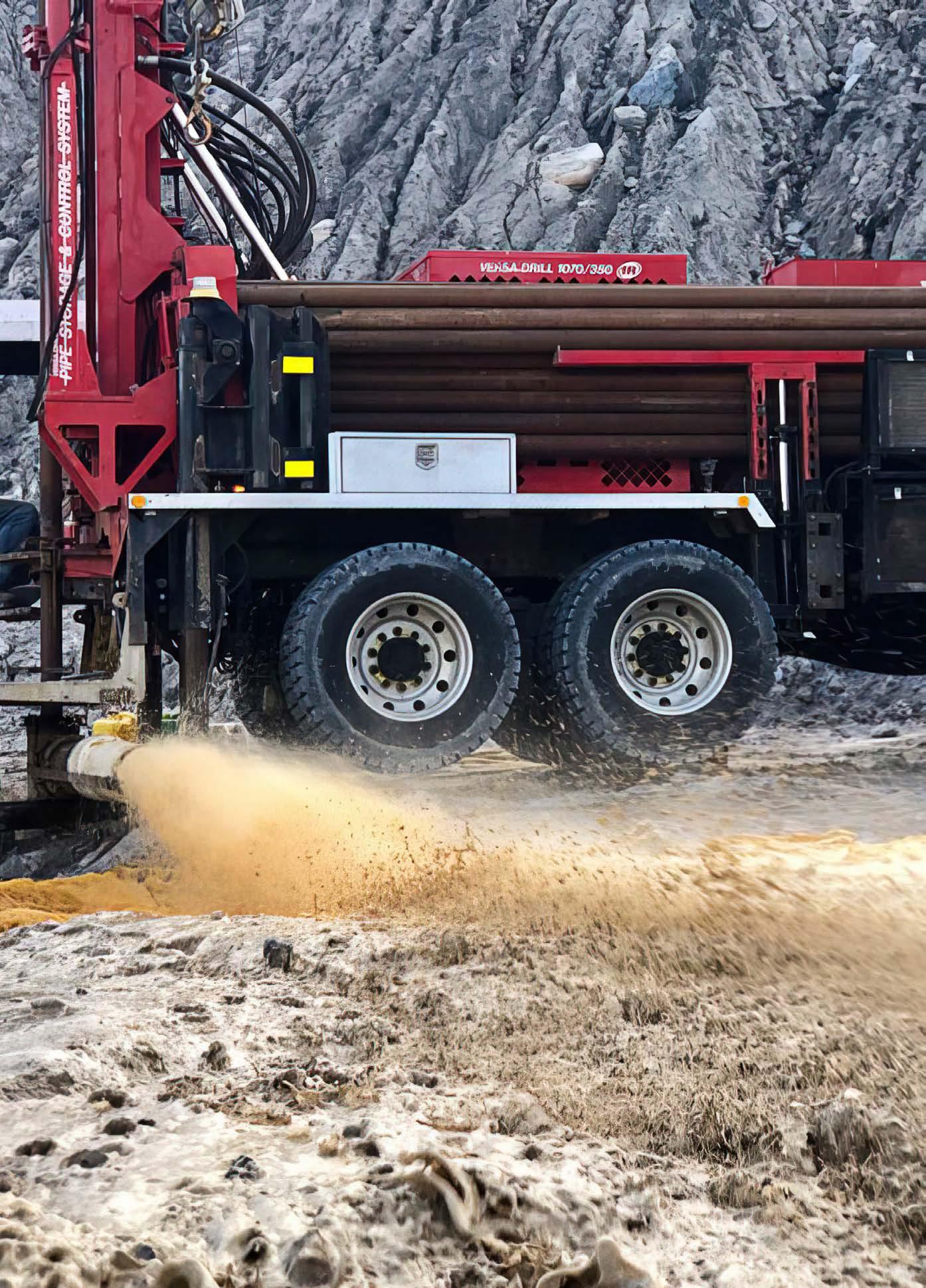
The ETF Securities Physical Gold ETF (ASX: Gold) also provides exposure to gold bullion. The ETF is unhedged for currency movements, meaning investors are also trading a view on the direction of the Australian dollar against the US dollar.

– 8 –
FEATHERSTONE REPORT
Interest rates have been climbing, but this is not expected to sustain long-term.
ETFs are becoming an increasingly popular investment medium, including in gold.


Production bores Artesian bores Monitor bores Dewatering Down hole hammer Cement grouting www.aquatechdrilling.com.au P 0490 282320 P 0438 800 389 E admin@aquatechdrilling.com.au Aquatech rigs have the capabilities to drill up to 1000 metres. With 3 rig sizes available they can cater for domestic, agricultural and large mining contracts. WATER BORE SPECIALISTS Providing long term drought resilience throughout Western Australia
— ANALYSIS — WITH REGINA MEANI
Uranium: Our underutilised resource
Australia has been mining uranium since the 1950s, but there have been restrictions on its usage and its purposes after export.
The Australian Government’s Environment Protection and Biodiversity Conservation Act 1999 (the Act) bans local nuclear energy, meaning Australia has no nuclear power-producing electricity.
The ban has cost Australia substantial global investment and the advancement of scientific collaboration on new nuclear technologies. But this ban can be reversed with a single amendment to the Act.
Uranium currently provides around 10 per cent of the world’s power, providing electricity to billions of people in more than 30 countries.
Australia has about 28 per cent of the world’s uranium resources and in 2021 was fourth to Kazakhstan, Namibia and Canada in production. As Russia’s war with Ukraine enters its second year, disruptions to European and US energy supplies have brought forward new constructions and additional incentives for nuclear power.
Russian uranium conversion accounts for 38 per cent of global capacity, while its enrichers are responsible for nearly half of the world’s supply.
But uranium has multiple applications.
In Australia, small special-purpose nuclear reactors have been making a wide range of radioactive materials (radioisotopes) at low cost. These radioisotopes play a significant part in medicine, food production,
livestock, and in the industrial and mining industries. A little-known example is that most household smoke detectors have a radioisotope derivative.
Uranium futures peaked at $US148 per pound (lb) in May 2007. From there the price initially fell dramatically into 2008 before commencing a downward sloping phase reaching a low point of $US17.75/lb in November 2016.
The price formed the preliminary stages of a base until September 2021, when the price broke away and continued its upward trend to head towards the $US55–65/lb resistance zone.

Support is located around $US46.50/ lb, and in the event this level is breached, back-up is in the $US30–40/lb zone. To initiate the next stage of base completion, the price needs to break away above $US54/lb before gaining the potential to head towards and beyond $US60/lb, then towards $US70/lb and possibly $US95/lb.
Boss Energy is focused on the restart of its Honeymoon uranium project in South Australia, with first production targeted for the fourth quarter of 2023. SA is a Tier 1 mining jurisdiction, with established export pathways to international energy markets.

Boss’ position is unique, with Honeymoon having a resource base of 71.6 million pounds of contained uranium oxide and a large inventory of 1.25 million pounds of physical uranium. This has been stockpiled to provide offtake flexibility and de-risk contract delivery during the project’s commissioning phase.
The Boss share price has anticipated the uranium price trends, finding pivotal lows
ANALYSIS WITH REGINA MEANI
– 10 –
Uranium futures reached a low point of $US17.75 in November 2016.
in June–July 2013 and completing the second stage of its basing process in December 2020. From there the price rose rapidly to achieve its initial objective of $2.80 in September 2021 where a pause/sideways action developed in reaction to overbought conditions and resistance.
The action has been largely confined between $1.80 and $3.10, with the price swings tightening more recently to between $2.25 and $2.75. These levels are short-term
identifiers for the next price move, above $2.75 for a test of $3.10 and below $2.25 for a drop to the lower parameters between $1.80 and $2.
The pause phase is likely to continue its influence over the price movements, but the base indicates the potential for the upward path to be resumed into the $4–5 area and conceivably beyond.
Another company exploring for uranium in Australia is Toro Energy.
The company’s centrepiece is the Wiluna uranium project located in the northern goldfields of Western Australia. Wiluna consists of the Centipede, Millipede, Lake Maitland and Lake Way deposits. The company has received federal and state government environmental approvals for mining uranium at the project.
In addition, Toro Energy holds exploration interests in Namibia and Africa, and an investment in Canadian-based uranium explorer Strateco Resources.
The Toro price followed the uranium price closely until January 2018, but from that point the price diverged and continued its downward path, unable to base in a similar fashion as uranium.
The share price reached a pivotal low in March 2020, supporting a significant recovery and gaining almost nine times its price within a 12-month period. After stretching into overbought conditions, the price halted and entered a volatile phase which is still influencing the price movements.
A near-term rise through $0.02 would indicate the potential to return the price to a less volatile phase, but until this level is broken the price is at risk of retesting its lows, creating a buying opportunity going forward.
Once the $0.02 level is cleared the price would likely head towards $0.04, with the prospect of moving beyond.
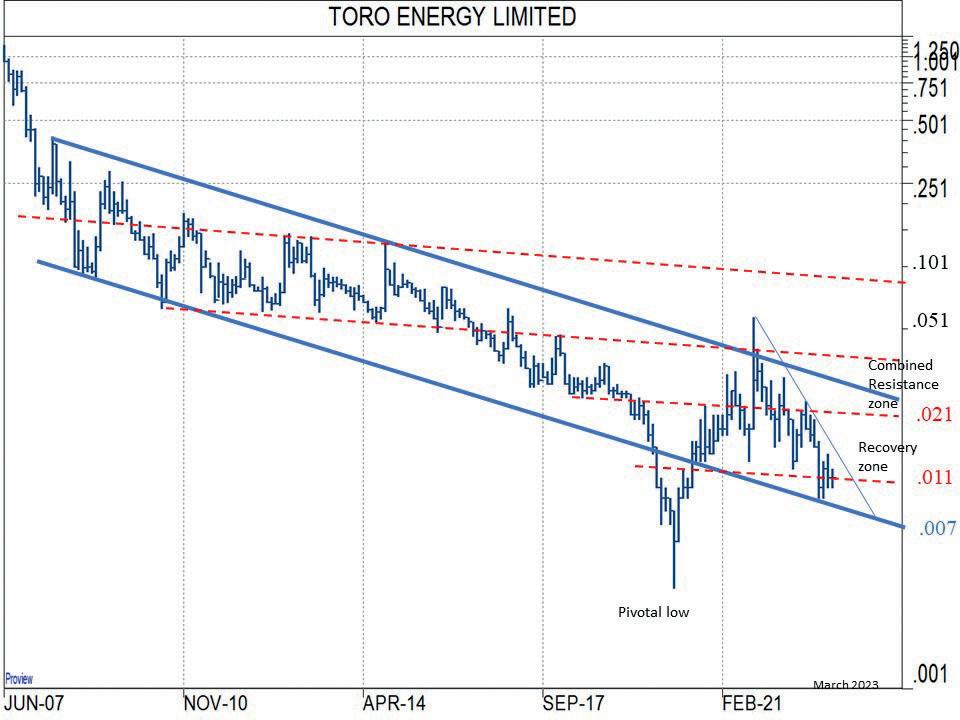

Based in Sydney, Silex Systems is engaging in the research and development, commercialisation and licence of SILEX laser uranium enrichment technology in Australia.
The Separation of Isotopes by Laser Excitation (SILEX) process is currently the only third-generation enrichment technology at an advanced stage of commercialisation. The process provides much higher enrichment process efficiency compared to earlier methods, potentially offering significantly lower overall costs.
In February this year, the company found very strong support for an equity raising that will allow the acceleration of their commercialisation activities. This comes at a time of increasing impetus to improve global nuclear supply chain security and to support a smooth transition toward decarbonisation.
Following the capital raising, the price for Silex dropped back towards support, which is located around $3 with back-up around $2.60.
As the pullback phase continues, buying opportunities are likely to develop as we anticipate that once the uptrend resumes the price would head through resistance at $5.80–6 and potentially beyond.
AUSTRALIAN RESOURCES & INVESTMENT
– 11 –
The Boss Energy share price anticipated uranium price trends, finding lows in June–July 2013.
The Toro Energy price followed the uranium price closely until January 2018.
‘Graphite is the next lithium’
Renascor Resources, International Graphite and Quantum Graphite are three Australian-focused ASX-listed companies advancing strategies to be part of a graphite future. We take a closer look at their attributes.
One of the key raw materials in the green energy transition is graphite, but while Australia is a key producer of other battery metals such as lithium, nickel and manganese, there are no active Australian graphite mining operations.
Graphite is used as an input for anodes – one of two electrodes that make up a lithium-ion battery, with cathodes – made up of metals such as lithium, nickel and cobalt –the other electrode.
According to Benchmark Mineral Intelligence, demand for anodes grew by 46 per cent in 2022, while supply of flake graphite – the most geologically common form of natural graphite – enjoyed 14 per cent growth last year.
This created a supply–demand imbalance, with Benchmark observing a 25 per cent rise in the price for -100 mesh flake graphite.
The lithium-ion battery anode market also became flake graphite’s biggest end user in 2022, running ahead of traditional applications in foundry and refractory industries.
And the good news doesn’t stop there, with more incentives emerging for future graphite producers.
“Rising prices on strong anode demand are expected to incentivise new supply in 2023, where four new mines are anticipated to join the flake graphite market,” Benchmark senior analyst George Miller said.
“Alongside expansions at current mines in both China and Africa, supply is set to grow by around 15 per cent.”

Miller said the -100 mesh graphite market, the preferred mesh size for anode manufacturing, is set to experience a deficit in 2023, which might see advancements in the types of anode feedstock.
“This might include milling of larger mesh sizes to suit the battery market or the use of different mesh sizes to stymie a supply deficit,” he said. “Sustaining a raw material shortage in the natural graphite anode value chain risks curtailing natural graphite anode market share.”
Several Australian companies are looking to ignite the local graphite industry. Some are not only focused on producing raw materials, but also developing a downstream offering as well. Australian Resources & Investment profiles three of those companies.
RENASCOR RESOURCES
With a market capitalisation of more than $500 million, Renascor Resources is the highest profile Australian graphite company on the ASX. This is due to the significance of its vertically integrated Siviour battery anode material (BAM) project in South
FEATURED
– 12 –
International Graphite’s Springdale graphite project in WA.
Australia, which comprises a proposed mine and concentrator near Arno Bay on the Eyre Peninsula and a planned downstream purified spherical graphite (PSG) facility in Port Adelaide.
The Siviour mine area is massive, holding the world’s second largest proven graphite reserve and the largest graphite reserve outside of Africa. This could support a mining operation for 40 years.
Siviour received Program for Environment Protection and Rehabilitation (PEPR) approval in November 2022 – the second step in a two-step assessment process from the South Australian Government.
The PEPR approval enables Renascor to process up to 1.65 million tonnes of ore per annum, allowing the production of 150,000 tonnes of graphite concentrates per annum.
Renascor has the backing of the Australian Government through a $185 million loan facility, while the company was also successful in raising $70 million through an institutional placement in December 2022. This was priced at $0.275 per share.
Renascor managing director David Christensen said upstream development would be the company’s initial focus, as that’s where he sees market demand.
“The gap in (graphite) material right now is really on the upstream and that’s largely because the customer base has grown significantly on the anode side and on the midstream processing side to feed battery companies, but the mines haven’t caught up,” he told Australian Resources & Investment
Once flake graphite concentrates are produced from Renascor’s Siviour openpit mine and processing plant on the Eyre Peninsula, further processing at the Port Adelaide facility would deliver a midstream PSG product to support battery anode manufacturing.
Christensen provided further analysis of current graphite dynamics.
“If we see where we are with graphite right now, China produces two thirds of the world’s graphite but processes 100 per cent of the graphite that goes into anodes and then produces about 90 per cent of the anodes,” Christensen said.
“And they’ve really built up their processing capacity, both on the midstream … and on the anode side, and for that matter on the battery and the EV (electric vehicle) side as well.
“There may be even overcapacity there, but there’s undercapacity certainly in China on the flake graphite, so China has now become a net importer of flake graphite, and that’s really
what’s causing the increase in the price. The reason they’re a net importer is because they need to feed the lithium-ion battery sector.”
Given its bright future as a battery anode material, Christensen compared graphite’s prospects to another battery metal key to the EV sector.
“What we tell people is graphite is the next lithium, and the more people that figure it out the better because I think we’re going to see not just our prices, but a number of prices go up relatively quickly fuelled from the supply gap,” he said.
“So it’s a great opportunity and I think there’s a lot of ASX companies who look like they have some pretty exciting resources.”
INTERNATIONAL GRAPHITE
Founded in 2018, ASX-listed International Graphite was built on the premise that the graphite industry would need more downstream processing capacity outside of China as the demand for battery anode materials increased.
The company is developing a mineto-market business model, whereby raw materials would be mined from the Springdale graphite project in WA and fed into a downstream processing plant in the emerging renewable energy hub of Collie.
International Graphite successfully commissioned its micronising facility in September 2022, which the company believes is the most advanced known pilot-scale graphite micronising and spheroidising plant to be installed and operated in Australia.
Micronising is the critical first step in the downstream processing of battery anode materials.
“What micronising does is essentially takes a fine concentrate, which might be 100–150 microns in size, somewhere in that order, and essentially grinds it down to a 20-micron size,” International Graphite managing director and chief executive officer Andrew Worland told Australian Resources & Investment
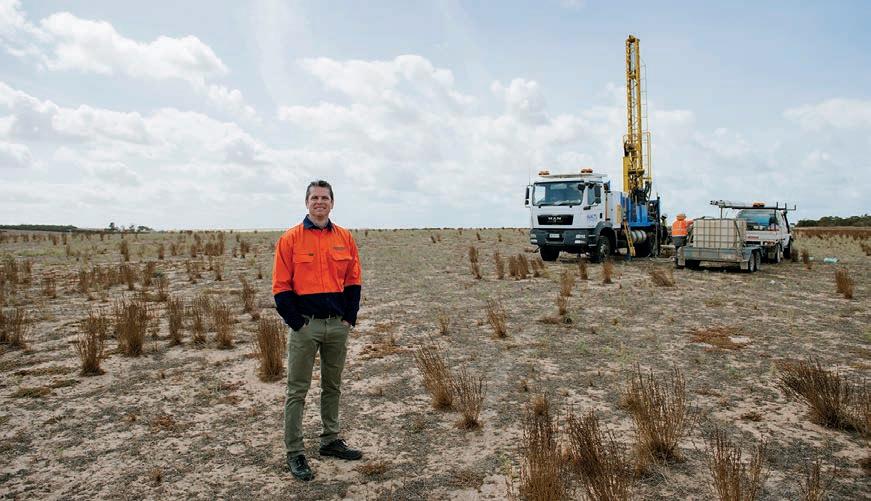
“Generally speaking, somewhere in the vicinity of 20 microns is what’s needed to progress a micronised graphite product through the battery anode process. You then spheroidise the micronised graphite and purify it, which involves taking a concentrate grade, let’s say 95 per cent, up to battery grade of 99.95 per cent.
“The final step is coating, and then you have a high-value product which is available for battery manufacturers.”
International Graphite’s Collie facility will also act as a centre for research and development (R&D) to explore the possibility of producing a finished battery anode material product.
The company acquired the Springdale project from Comet Resources in April 2022, with Comet seeing the value in International Graphite’s downstream potential. This was also reflective of broader investor sentiment.
“Where the industry was moving to more broadly from an investor perspective, was the value of a company was not being reflected in the mining assets but being reflected in the extent to which companies had explored downstream processing of their own materials,” Worland said.
“So Comet formed the view that merging the asset (Springdale) with our downstream processing IP (intellectual property) would yield a very nice consolidated business entity
– 13 –AUSTRALIAN RESOURCES & INVESTMENT
Renascor Resources’ Siviour graphite project is located on the Eyre Peninsula, South Australia.
that was all held in Western Australia and offered the benefits of ESG (environmental, social and governance) to the global marketplace. That was the basis of listing in April 2022.”
International Graphite commenced trading on the ASX following a $10 million initial public offering (IPO), and within a month the company had unveiled a larger graphite R&D facility in Collie and announced a new memorandum of understanding (MoU) with ZEN Energy to explore renewable energy options for its downstream facilities.
Drilling saw International Graphite identify several high-grade discoveries at Springdale throughout 2022, including Springdale Central and Springdale South.
In October 2022, the company finalised a $2 million financial assistance agreement with the WA Government to support the development of its Collie downstream facilities.
Worland said International Graphite could potentially commence importing concentrate before its Springdale project comes online.
“We can get that (our micronising plant) started on imported concentrates, and it may be, in time, a facility that we use to divert some Springdale material to as well,” he said.
“We’ll use that micronising facility to develop a customer base and generate cash flow into the company in 2024, before the feasibility study for Springdale and the feasibility studies for the battery anode material plant in Collie have been developed and completed.”
International Graphite’s strategy doesn’t stop there, with the company taking a holistic view at its development to find the best pathway forward.
“One of the challenges that all development-stage resource companies have in looking to get downstream is the timing to market,” Worland said. “This is certainly the case within the graphite industry.
“It takes a lot of integration of facilities and of course there’s a qualification process which is reasonably unique to graphite from a battery anode perspective that all companies need to go through. This does delay your market entry point.
“What we think is a very nice way to bridge that market entry is through establishing this micronising facility, which will be profitable very quickly. This will generate cash flow for the business that will help develop the feasibility work that we need to complete for Springdale and Collie.
“Just as important as cash flow is the market intelligence in customer networking. It’s the experience in sales and logistics that is something that doesn’t sit within any development-stage companies at this point in time. It’s a skill set that we’ll have through operations that others won’t.”
QUANTUM GRAPHITE
The Uley mine in South Australia was the sole Australian graphite producer when it was up and running between 2014–15. Uley was placed on care and maintenance in December 2015 by Valence Industries, before the company was rebranded as Quantum Graphite in July 2017.
Quantum Graphite is advancing Uley to a restart – as Uley 2 – where it aims to produce 55,000 tonnes per annum (tpa) of flake graphite from its processing plant. This would be generated from 500,000tpa of feed. The expected mine life is 12 years.
The company has been undertaking significant site works at Uley 2 before installation of the new processing plant commences, which involved remediation of the Uley legacy plant.
Recent achievements for Quantum Graphite include the renewal of its Mikkira exploration licence until October 2027. Mikkira covers much of the southern tip of the Eyre Peninsula and includes Uley 2, as well as other prospects such as Salt Lake, Homestead, Kacey and Fishery.
In November 2022, Quantum Graphite announced the successful completion of an energy storage project undertaken at INEMET in Freiburg, Germany. This involved testing and measuring the thermal performance of QSP’s flake graphite-based storage media under the same temperatures of the longduration energy storage (LDES) battery developed by Sunlands Co.
QSP is a joint venture between Quantum Graphite and Sunlands Co. focused on the manufacture of flake graphite-based thermal storage media, with the flake to be exclusively sourced from Uley 2.
Thermal storage uses heat to store energy for later use, which offers a renewable source of energy and potentially reduces the reliance on fossil fuels for energy generation.
Quantum Graphite non-executive director David Trimboli said the findings from the INEMET test work program were significant.
“These results now settle the scope of QSP’s manufacturing of Uley media blocks,” he said. “The big news is the uniformity in the heat storage results. This enables QSP to achieve efficiencies of scale in the size and type of Uley media blocks regardless of the configurations required by Sunlands Co. for its various LDES cells.
“Operationally the capability to utilise all the Uley 2 flake product range hands QSP significant operational control over the procurement process (eg timing, general market conditions etcetera) of Uley 2 flake inventory.”
Quantum Graphite launched a takeover bid for graphite explorer Lincoln Minerals in August 2022, which was still active at the time of publication (mid-March 2023) and had been extended four times by Quantum.
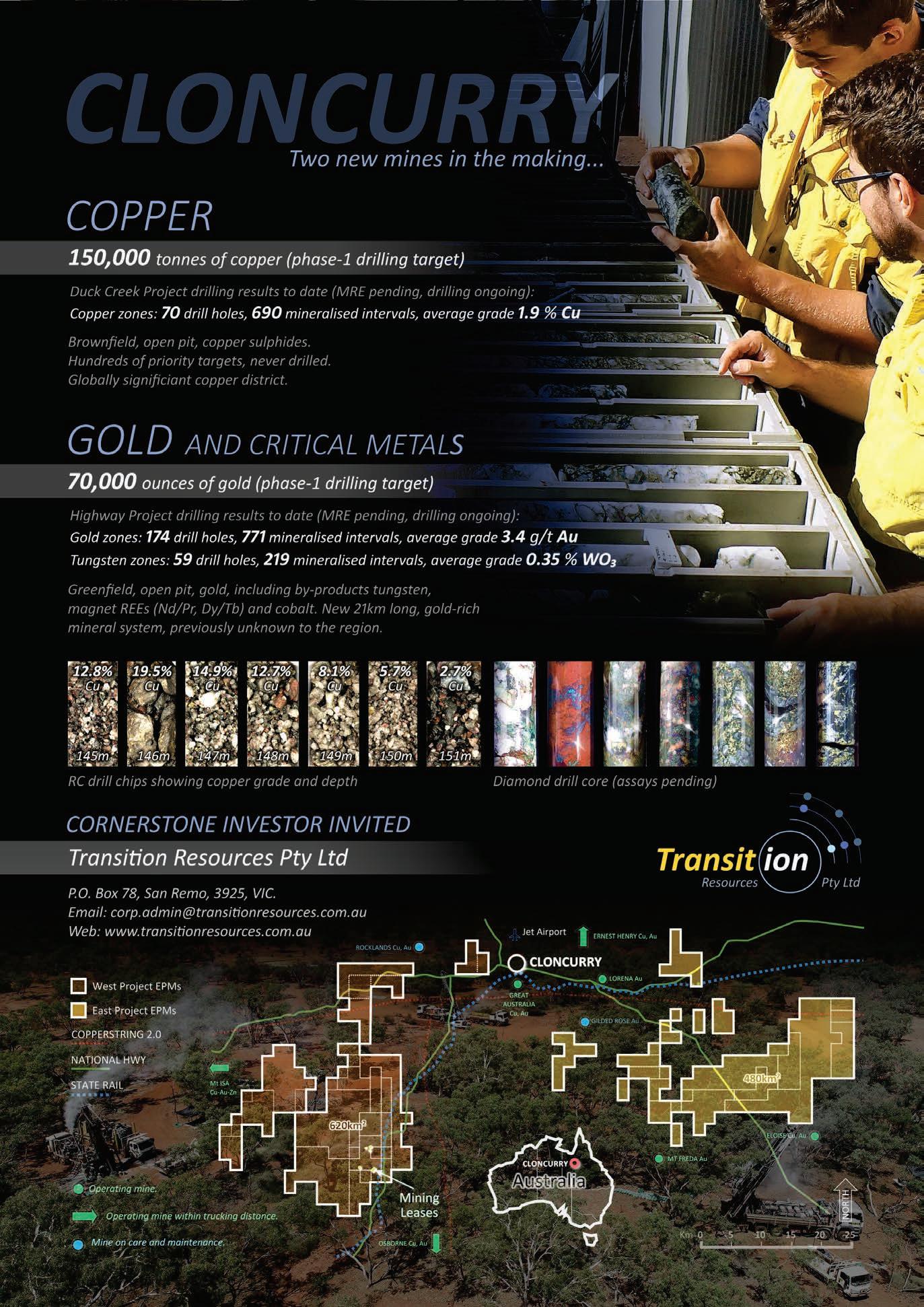
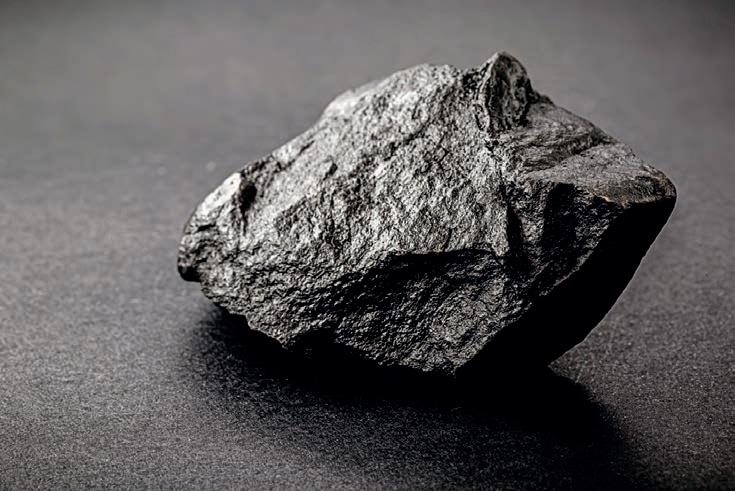
In a letter to its shareholders in late February, Lincoln Minerals said Quantum Graphite’s offer remained unsatisfactory, while highlighting its own attributes where it is fully funded for 2023 exploration.
Drilling at the Koppio graphite project and Kookaburra Gully graphite deposit was set to commence in March.
– 14 –FEATURED
Graphite has a bright future as a key ingredient in lithium-ion batteries.

Australia’s bright copper future
After retreating to a 20-month low in July 2022, copper prices rebounded in the months following and nudged $US4.30 ($6.43) per pound in January.
Fitch Solutions said copper prices would be supported this year by China’s pivot away from a zero-COVID policy.
“With our expectations for Chinese demand to recover in the coming months, copper prices will remain supported and edge higher in 2023,” Fitch said in a February report.
“We highlight political and community unrest in Latin America that are likely to keep the copper market tight.”
Fitch indicated social unrest in Peru following the ousting and arrest of former president Pedro Castillo in December 2022 had heightened risks for mining operations in the world’s second-largest copper-producing nation.
“Additionally, operational setbacks and regulatory headwinds in neighbouring Chile and the prospect of a mine shutdown in Panama as the government there seeks a bigger share of profit will further keep the region’s copper supply at bay,” Fitch said.
The long-term demand profile for copper
is significant amidst the green transition as the base metal is a highly efficient conduit for renewable energy systems such as solar, wind, hydro and thermal energy.
And geopolitical concerns in South America have solidified Australia’s position as a stable jurisdiction and partner for copper buyers globally.
There are a host of Australian-focused copper mining and exploration companies that have a key role to play in the years to come, including mid-tier copper producer Aeris Resources.
Aeris produces copper from its flagship Tritton operations in the Cobar region of NSW, its Jaguar mine in the Eastern Goldfields of WA as well as its North Queensland copper operations.

The company achieved approximately 27,300 tonnes of copper equivalent production from its operations in the half-year to December 31, and growth projects are advancing on a number of fronts.
This includes multi-faceted exploration at Tritton, where airborne electromagnetic surveying is being complemented by drilling
programs.
Mining from Tritton’s Avoca Tank and Budgerygar deposits will displace 1.1 per cent copper grades with 2.5 per cent and 1.8 per cent, respectively, in the coming months. Budgerygar is currently in production while Avoca Tank is set to come online in the June quarter of 2022.
Aeris executive chair André Labuschagne said the company’s aspiration is to turn Tritton into a 30,000-tonne, 10-year mine life operation.
“How we will do this (achieve 30,000 tonnes) is we are progressing out of low-grade underground mining at Tritton at depth to higher-grade deposits being Avoca Tank and Budgerygar,” he told Australian Resources & Investment.
“The next step would be bringing in Constellation which is a new discovery we did two years ago and bring that into the pipeline of production.”
Aeris announced its Constellation discovery in November 2020 and the company has been bolstering the prospect ever since, with a maiden Constellation resource announced in December 2021 and a mineral resource update revealed in August 2022.
The updated mineral resource estimate (MRE) demonstrated Constellation’s potential to produce 6.7 million tonnes of ore at 1.85 per cent copper, 0.58 grams per tonne (g/t) gold and 2.9g/t silver. This equates to approximately 123,000 tonnes of copper, 125,000 ounces of gold and 620,000 ounces of silver production.
Labuschagne said Tritton’s deposits continue to surprise.
“What we’ve found with all these (Tritton) deposits has been that they keep extending at depth,” he said. “So at Murrawombie, two years ago we thought we only had about two years left and now we think there’s three or four years left because we drilled a hole deep underground and we discovered that it continues.
“So for Tritton, it’s about turning the operation into a hub-and-spoke model, basically mining three or four mines at a time delivering 30,000 tonnes of copper. Now if you
– 16 –FEATURED
Through its suite of Australian copper operations, Aeris Resources has an important role to play to support a ballooning copper demand profile.
Aeris has added several mines to its portfolio in recent years, including Jaguar, Mt Colin and Stockman.
generate 30,000 tonnes of copper out of Tritton, you’ll generate good cash and that’s the aim –you’re turning Tritton into a Tier 2 asset.”
Labuschagne said Aeris’ Jaguar and North Queensland operations also had an important role to play in a copper future, while the emerging Stockman copper-zinc project in Victoria would also add important tonnes to the company’s output.
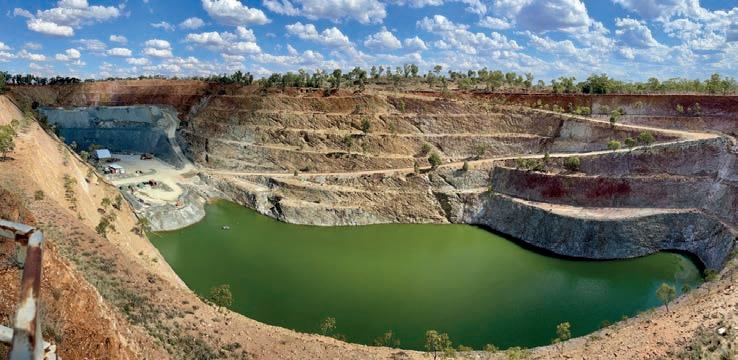
Aeris acquired these three assets through its acquisition of Round Oak Minerals in 2022.
As for the global copper outlook, Labuschagne said there might not be enough supply to meet lofty future demand forecasts.
“I do have a view that we will not be able to produce copper fast enough if what the government and industry are planning on renewables works out,” he said.
“So what does that mean? There will be a deficit. And what does that mean? The price will go up, but I do think the capital investment cannot go fast enough to deliver the supply we would need if everyone could achieve their targets.”
While Fitch expects the copper price to average $US8500 per tonne ($US3.86 per pound) in 2023, this will steadily increase year-
by-year before reaching an expected $US10,400 per tonne ($US4.72 per pound) in 2028.
“We forecast global copper consumption … to rise in 2023 with 3 per cent growth, amid a more positive economic outlook for China, increased demand from the autos sector and the acceleration of the low-carbon energy transition,” Fitch said in a January report.
“Over the rest of the coming decade, however, we anticipate strong demand growth driven by the power and construction
industries, rising electric vehicle production and a broadly upbeat global economic growth outlook.
“We expect global copper demand to increase from 26.5 million tonnes in 2023 to 34.9 million tonnes in 2031, averaging 3.1 per cent annual growth.”
There’s no doubting copper has an important role to play in the years ahead, and Australian copper producers such as Aeris Resources are set to benefit significantly from a ballooning demand profile.
The Adelong Gold Project
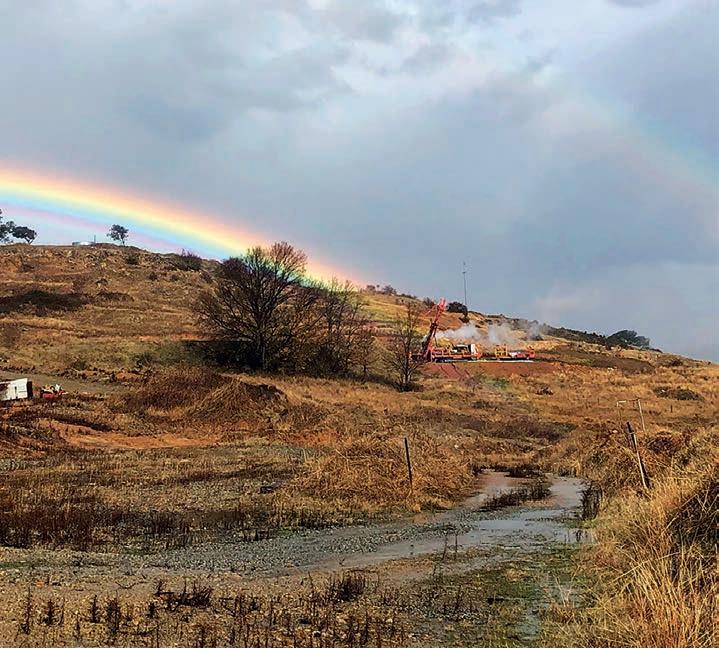
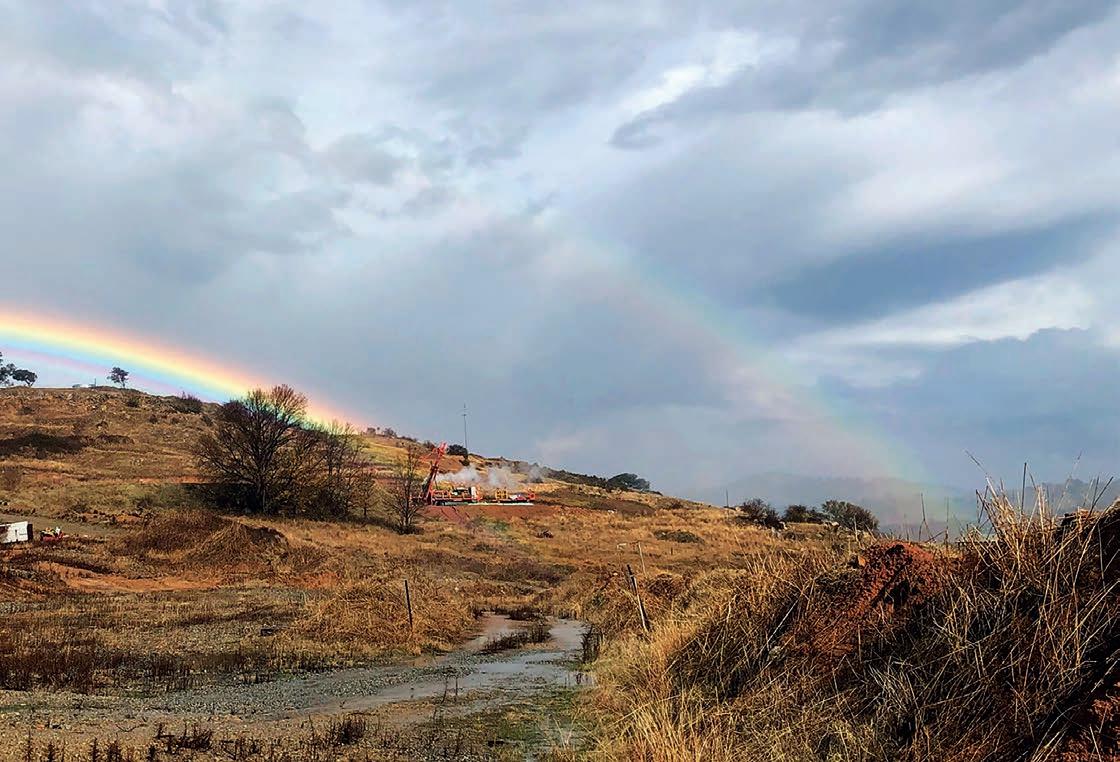 Aeris Resources’ Tritton copper operation in NSW.
Aeris Resources’ Tritton copper operation in NSW.
An Attractive Development Opportunity 800k oz historical production 170k oz total JORC resource On-going exploration expected to expand resource further Scoping study confirms a viable project Processing plant on site with 100% ownership Strategy of resource exploration, plant upgrade and re-opening of mine Located in the township of Adelong, Southern NSW Hole intersected 5m@ 9.16g/tAu adelonggold.com.au ASX ADG – 17 –AUSTRALIAN RESOURCES & INVESTMENT
Cloncurry: Australia’s key copper district
Transition Resources has spent just over four years exploring the highly prospective Cloncurry region near Mount Isa. The investment has paid off with the company recently unearthing a rare copper discovery.
Cloncurry is historically one of Australia’s richest areas for base and precious metals production. That’s why it was a surprise to Transition Resources when it began acquiring ground in the area in 2017 only to discover that many tenements sat uncontested.
Cloncurry, along with Mount Isa, sits within the North West Minerals Province (NWMP) in Queensland.
Transition now boasts more than 1100 square kilometres of highly prospective exploration and mining tenements in two project areas east and west of Cloncurry.
Transition founder and managing director David Wilson said the company’s initial strategy was to take a closer look at some of the unique geological prospects in the region,
in hopes of identifying new deposits such as its Success cobalt mine, which has yielded ore at up to 50 per cent cobalt.

“The Cloncurry district – and the NWMP more generally – is a highly attractive exploration destination for a range of metals including rare earth elements, critical metals, base metals, precious metals, and actinides,” he told Australian Resources & Investment.
“However, the NWMP still remains remarkably underexplored and significant exploration opportunities exist.”
Transition’s investment into the region paid off when the company unearthed significant copper and gold deposits in its new turf.
Wilson said that while Transition had many project opportunities, it was currently
focused on a handful of its advanced prospects in the region.
The Highway project in west Cloncurry is a 750m-long zone of high-grade gold with significant by-products of tungsten, cobalt, and rare earths.
“We subsequently linked the Highway project to a 21km-long gold-rich mineral system which was previously unknown to the region,” Wilson said. “This is likely to host swarms of deposits similar to the Highway discovery.”
Transition now plans to progress the Highway discovery towards a decision to mine.
The company also owns a number of tenements around Duck Creek in the NWMP, many of which have yielded exciting copper discoveries.
“Our Duck Creek tenements include some of the most densely mineralised areas of the Mount Isa Inlier,” Wilson said. “We’ve identified over 550 historical prospects and dozens more are being identified every year as we continue exploration.”
Though Duck Creek has historically been heavily explored, prior drilling was quite limited and typically localised to just a handful of prospects.
“The historical view has been that Duck Creek mineralisation is shallow, so earlier explorers drilled very few holes below 50m from the surface,” Wilson said. “Our recent drilling efforts have intersected high-grade copper sulphides as deep as 280m, and it remains open at depth.
“But our most important zones have been intersected at depths less than 200m below surface, which offers cheaper open-pit mining options. The average copper grades so far are roughly double those of most undeveloped copper prospects in Cloncurry.”
Internal modelling indicates the resource scale at Cloncurry is already enough to
– 18 –COPPER
Transition has experienced plenty of exploration success in the Cloncurry region.
support a hub-and-spoke, mine-and-haul development model. But Transition believes its exploration results so far provide evidence of a more substantial system at depth.
Wilson said there was a lot more to its recent Duck Creek discovery than just luck.
“Transition’s success follows four years of exhaustive research and development,” Wilson said. “We are now converting this new knowledge into commercial opportunities.”
The Duck Creek discovery hasn’t changed Transition’s plan moving forward. Instead, it’s cemented the company’s existing strategy.
“Our plan from the outset has been to define sufficient shallow sulphide resources to support near-term mining at the Duck Creek tenements,” Wilson said.
“The new copper discoveries mean that Transition should soon be able to define mineral resources that will support mine planning.”
Transition has also identified a 250m-long zone of shallow, high-grade rare earth elements (REEs), including high-grade magnet REEs, from drilling at the Toolebuc prospect in its east Cloncurry tenements.
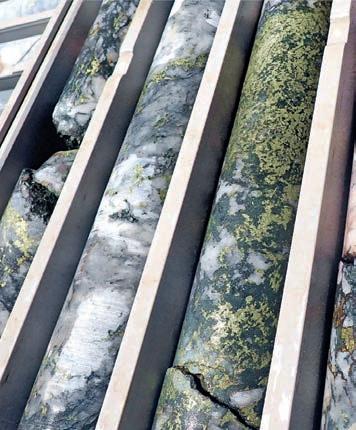
“Mineralisation at Toolebuc remains open and the system is not yet understood,” Wilson said.
“Geophysics has identified a large, 2kmwide conductive anomaly that aligns with a circular magnetic anomaly immediately east of the identified REE zone. These represent immediate ongoing drilling targets.”
Wilson said as one of Australia’s largest copper-producing regions, Cloncurry has an important role to play in global decarbonisation.
This has seen the region become a hotbed for consolidation, with recent deals including Evolution Mining buying the Ernest Henry copper-gold mine from Glencore, Harmony Gold’s acquisition of Copper Mountain’s Eva copper project and Aeris Resources’ acquisition of Round Oak Minerals.
“Cloncurry has a rich history of copper production which has ebbed and flowed in concert with commodity cycles for more than 120 years,” Wilson said.
“As the global investment community embraces the link between copper and a lowcarbon future, producers are wondering how they will meet future demand.”
Wilson said the looming copper supply squeeze, along with Glencore’s recent copper divestments, were creating opportunities for smaller explorers in the region.
“We’re seeing small to mid-tier groups positioning for future growth, each wanting to be the next big copper producer,” Wilson said. “There are larger groups like Evolution, Harmony Gold and Aeris moving into the area through acquisitions.
“This is happening because organic growth – such as through the discovery of new deposits – is no longer a reliable business model. New discoveries are getting harder, which is what makes our Duck Creek and Highway discoveries so exciting.”
As it stands, Transition has 50 shareholders (12 of whom are staff) and a current market capitalisation of $55 million. The fact most staff are also shareholders speaks to the company’s commitment and passion.
“Everyone here is fully invested in the company’s success for the sake of its shareholders,” he said.
With hundreds of prospects yet to be tested, including multiple targets identified at depth, as well as a handful of bountiful discoveries, Transition has an exciting pipeline of projects in the Cloncurry region.
And the company has even hinted at a potential ASX listing either late this year or early next.
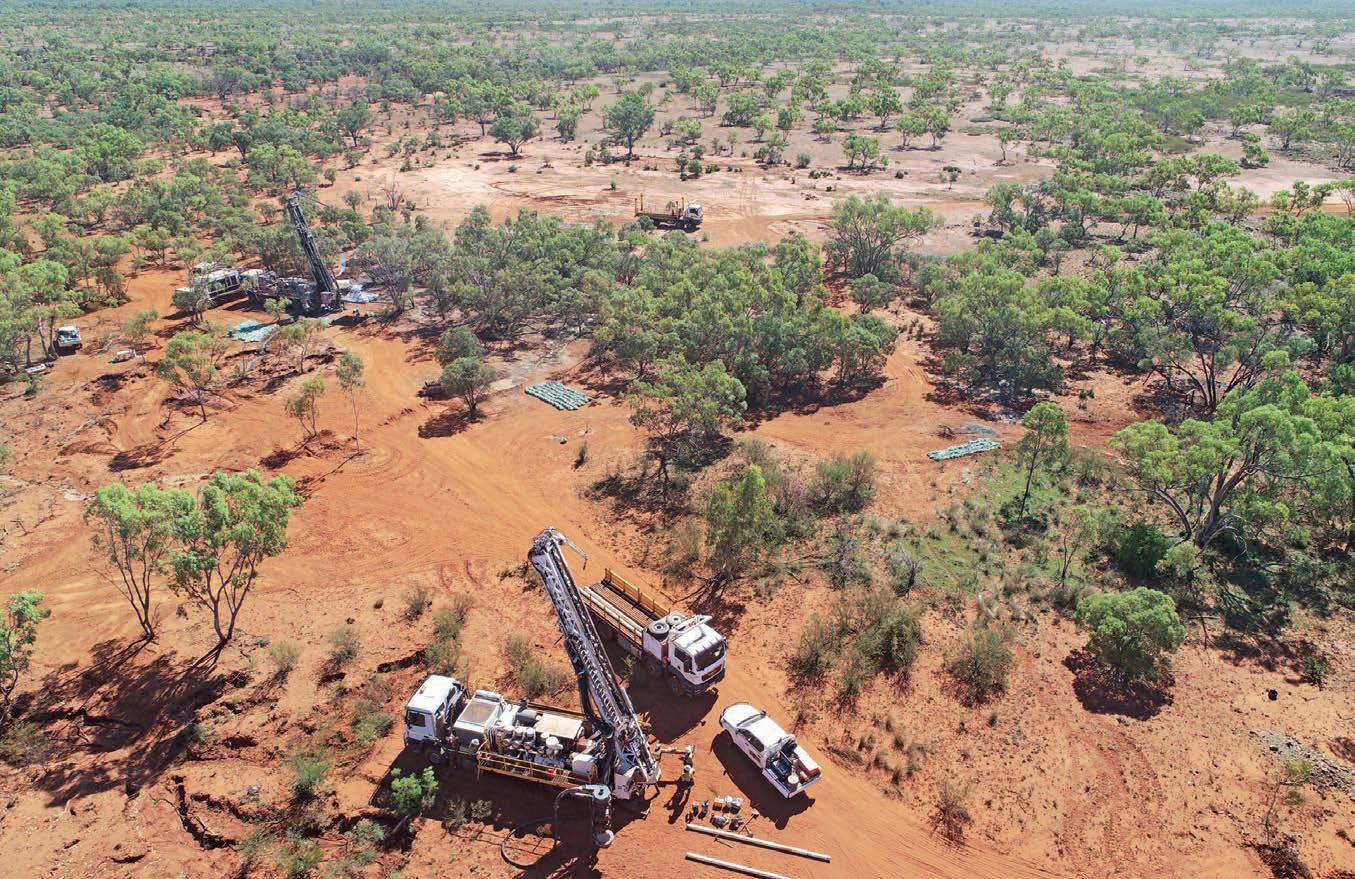
– 19 –AUSTRALIAN RESOURCES & INVESTMENT
Transition holds more than 1100 square kilometres of exploration and mining tenements in the Cloncurry region.
Transition is exploring for a range of commodities in the Cloncurry region, including gold, copper and rare earths.
Why 2023 is a pivotal year for lithium prices
Supply chain insecurities have created a potentially transformative opportunity for Australia, Alexandra Colalillo writes.
Five years ago, the lithium industry’s primary concern was insufficient investment.
As investors paid increasingly more attention to developments in the sector, we have seen lithium prices soar since 2021 on the back of booming global electric vehicle (EV) sales. This saw the total spot value of lithium consumption reach $35 billion in 2022, up from $3 billion in 2020.
The scale at which price hikes continued throughout 2022 was unprecedented, despite the expectation that lithium demand would continue to outpace supply.
These prices were buoyed by ongoing global supply shortages from outpaced demand for EVs and renewable energy storage systems, coupled with supply-chain disruptions.
Market dynamism has been compounded by an over-reliance on China, which controls almost 60 per cent of the world’s capacity for refining and processing battery metals, and the invasion of Ukraine, which has seen economic
sanctions enacted against Russia, one of the world’s key suppliers of lithium products. However, these insecurities have created an economically transformative opportunity for Australia on a scale that surpasses the country’s previous dominance in commodities. Not only is Australia the world’s largest exporter of iron ore, liquefied natural gas (LNG) and coal but spodumene concentrate – a raw form of lithium – is now on the list.
What will be the decisive factor affecting the lithium market in 2023?
Demand for EVs is forecast to rise by over 40 per cent over the next two years, which will continue to support prices. But future price uncertainty is governed by a number of other factors: whether supply growth is able to keep up with demand, the emergence of new lithium mines with project execution success, geopolitical and economic instability, and the rise of alternative battery technologies.
Considering these factors, the lithium outlook remains positive, with average prices in 2023 likely to fall by approximately 8 per cent from 2022.
FACTORS KEEPING PRICES AFLOAT
By 2040, the International Energy Agency expects demand for lithium to grow more than 40 fold if the world is to meet its Paris Agreement goals. Lithium demand will therefore continue to grow as more countries pledge to reduce carbon emissions and invest in EVs and energy storage systems, both of which rely heavily on lithium-ion batteries.

As the world’s largest electric vehicle market, China is expected to remain the largest lithium consumer in the coming years, with demand on track to grow to 180,000 metric tons by 2030. As battery supply chains begin to develop, demand for lithium is also set to pick up considerably in the rest of Asia, Europe, North America, and India.
In fact, half of all new cars sold in the US are set to be electric by 2030, with similarly ambitious plans in place across the Western world.
To support these plans, policies such as the US’ Inflation Reduction Act have increased EV tax credits to $7500 on qualified vehicles through to 2032, a move designed to bolster demand. The Act also contains new sourcing requirements, explicitly offering subsidies for automakers that diversify their EV battery supply chains out of China.
This Act, coupled with US tariffs on imported goods that contain lithium
LITHIUM
– 20 –
By 2040, the International Energy Agency expects lithium demand to grow more than 40 fold.
from China, has made it more expensive for US companies to manufacture EV batteries, propelling lithium prices in 2023. If geopolitical tensions continue to escalate, it could lead to further supply-chain disruptions, contributing to continued price volatility.
FACTORS PLACING A DOWNWARD PRESSURE ON PRICES Demand
China’s decision to withdraw its decadelong subsidies for EV purchases as of January 2023 has exacerbated affordability issues and ultimately softened demand. In response, automakers have increased EV discounts in order to maintain sales. Companies such as Tesla have already cut prices by 12 per cent since September 2022. Subsidy withdrawals coupled with China’s surging COVID-19 cases will continue to dampen demand over the next six months.
We saw lithium carbonate prices fall in China to a 13-month low of CNY362,500 ($77,660) per tonne in early March, the lowest since June 2022 and over 20 per
cent down since their all-time high of CNY600,000 ($128,542) per tonne in November 2022.
Beyond 2023, two additional demand factors are at play.
First, advancements in alternative battery technologies, such as solidstate batteries, are seen as a potential replacement for lithium-ion batteries due to their higher energy density, longer lifespan and increased safety. Companies including BMW, Dyson and Toyota are already investing in solid-state battery technology; however, it could take several years before they become commercially viable and for lithium-ion batteries to be replaced on a large scale. EV batteries also typically have a 10-year function life, with the potential to create a large challenge for future waste management.
Second, while there is a global push to utilise critical minerals like lithium in order to decarbonise, the impact of mining this commodity carries environmental and contamination risks given current practices are energy and chemically intensive.
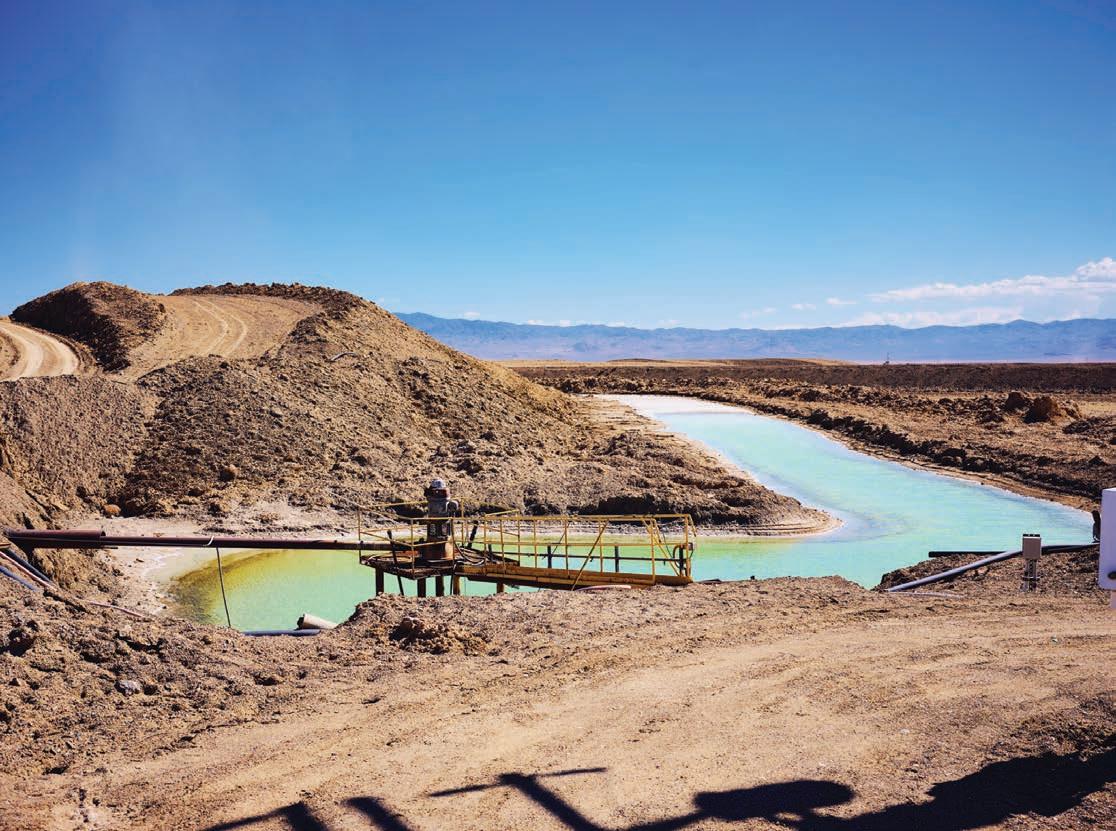
Supply
While the lithium supply shortage remains, we could expect prices to fall from a supply wave that may hit the market in 2023, prompted by a boost in production capacity from existing and near-term producers in Australia and South America’s ‘lithium triangle’ of Chile, Argentina and Bolivia, which together hold the majority of the world’s known lithium resource. Chile alone is responsible for a quarter of world production and holds more than 40 per cent of global reserves, followed by Bolivia (24 per cent) and Argentina (21 per cent).
Australia was the world’s largest lithiumproducing country in 2022, with its largest lithium mine, Greenbushes, contributing 40 per cent of global supply.
Greenbushes, among other growing hard-rock lithium operations in Western Australia and the Northern Territory, is subject to future expansions, including for lithium chemicals. As a result, projected global output of lithium carbonate from top producer, Australia, is expected to reach 915,000 tonnes in 2023, a 3 per cent rise from 2022’s estimate. Lithium shortages
– 21 –
AUSTRALIAN RESOURCES & INVESTMENT
A brine pool for lithium mining. Lithium brine is primarily produced in Chile, Argentina, China and the US.
are expected to ease as this supply comes online, placing a downward pressure on prices.
Despite a broad agreement pointing to a major increase in lithium supply in 2023 following a wave of expansions and emerging projects, the divisive question is whether they will successfully deliver and meet sustained demand forecasts.
Discussions about hopeful expansions rely on top producers from Chile, China and Australia. However, if these larger players hit hurdles in launching volumes of lithium supply due to the complex extractive industry, global production forecasts are expected to be pegged between 22–42 per cent in 2023.

Concern is also channelled toward the less-established producers who are subject to tough regulatory, technical and commercial challenges. While the emergence of new lithium mines in countries such as Canada and the US are on the horizon, these challenges, as well as seeking a knowledgeable labour force, are likely to delay the time in which these mines become operational.
DOES THIS PRESENT AN OPPORTUNITY FOR AUSTRALIA?
Australia is in great stead to position itself as a critical minerals mining and refining superpower due to the scale of our wind and solar resources, sparsely populated continent and financial market stability. These factors, combined with the country’s energy independence, supply-chain security and critical geostrategic consideration, presents a large opportunity for Australia.

With the rising global commitment toward decarbonisation, Australia is at the beginning of a global significant investment boom, with its top-five ASX-listed lithium firms holding a collective market capitalisation in excess of $50 billion.
Australia is already the world’s largest producer of hard-rock lithium spodumene and by 2024, Australia is expected to account for 10 per cent of global lithium hydroxide monohydrate (LHM) production. Given China currently processes 60 per cent of the world’s LHM, almost all sourced from Australian lithium spodumene mines, this emphasises the strategic opportunity for Australia to value-add before export.
The development of these lithium processing and associated downstream industries in WA will also benefit the economy, projected to create up to 52,000 Australian jobs in the state by 2050.
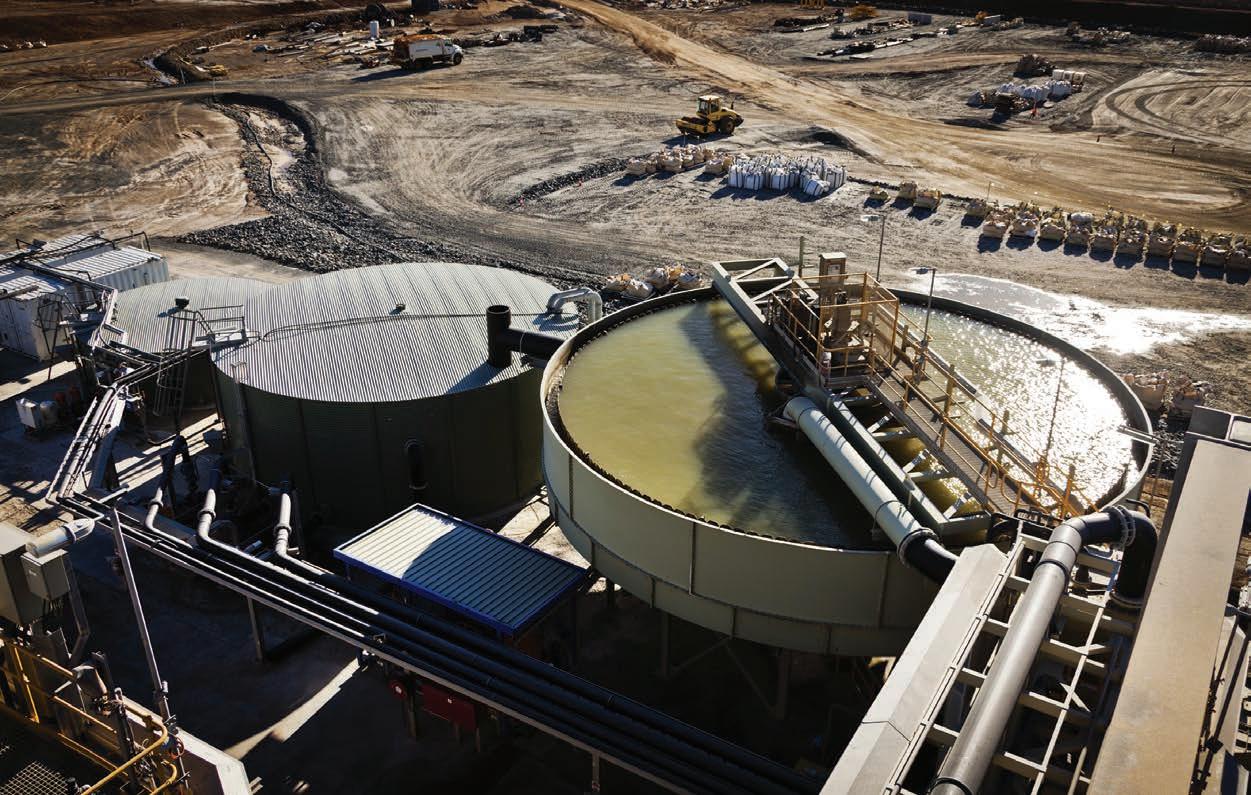
– 22 –LITHIUM
Alexandra Colalillo is an economist in her independent capacity and a manager at a global professional services firm. A key part of Alexandra’s role involves assisting mining organisations respond to risk and fluctuating economic conditions to minimise financial and operational uncertainty.
Australia is the world’s largest lithiumproducing country.


Connecting talent with industry. powered by careerone hiring.australianresourcesandinvestment.com.au ADVERTISE JOBS TODAY
New shark in town
Now that Andromeda Metals has received final regulatory approvals from the South Australia Government, the company is set to commence constructing its Great White halloysite-kaolin project.

Australia is the world’s biggest lithiumproducing country, while the country also ranks among the top producers of four other essential commodities: iron ore, bauxite, rutile and zircon.
While miners climb over one another to be the biggest and the best, grappling with the whims of consumer demands, others have carved their own path.
In recent years, Andromeda Metals has been advancing its Great White project as it looks to become Australia’s first halloysitekaolin producer.
Halloysite-kaolin is considered the most researched clay mineral in the world. It’s exceptionally rare, and highly valuable thanks to its unique tubular microstructure.
Now that the SA Government has approved the project’s Program for Environment Protection and Rehabilitation (PEPR) – the second and final regulatory approval – the company is poised to commence constructing Great White.
“We are very excited to have received approval of the PEPR as it brings Andromeda closer to becoming a globally significant producer of halloysite-kaolin products,” Marsh said.
“With this important regulatory milestone now achieved, Andromeda is poised to progress towards construction, as we advance funding discussions which will enable a final investment decision,” he said.
Approval of the PEPR permits the processing of up to 300,000 tonnes per annum (tpa) of ore equating to the production of 150,000tpa of halloysite-kaolin.
The PEPR also enables the staged development of Great White along with the mine’s first 13 years of production.
Prior to achieving its PEPR approval, Andromeda had been hard at work laying the corporate groundwork for Great White production.
In March 2021, Andromeda executed an agreement with Japanese porcelain manufacturer Plantan Yamada for its Great White CRM product, which will see the company purchase 5000 tonnes per annum of halloysite-kaolin at $700 per tonne for use in ceramics.
Then in August 2022, Andromeda and Plantan Yamada signed an additional offtake agreement involving the supply of up to 43,000 tonnes of the Great White KCM 90 product.
Plantan Yamada will receive halloysitekaolin across the first three years of Great White’s operation with price reviews at 12 months and the potential for further extension.
The Japanese porcelain manufacturer had been analysing and testing samples at laboratory, pilot scale and full commercial scale over the prior three years including a 40tonne batch of Great White material.
This was the second binding offtake agreement for the Great White KCM 90 product, with Andromeda signing a binding offtake term sheet with Vietnam and Hong Kong-based Asia Mineral Resources in July 2022 for the supply of up to 38,500 tonnes of KCM 90.
In June 2021, Andromeda also established an offtake partnership with Jiangsu Mineral Sources International Trading Co. for its Great White PRM product.
This will see the Chinese commodity trading house purchase 70,000 tonnes per annum of Andromeda’s halloysite-kaolin product for more than $700 per tonne to be used in the coatings and polymers market. This is distinct from the CRM and KCM 90 products to be sold to Plantan Yamada and Asia Mineral Resources.
HALLOYSITE-KAOLIN
– 24 –
Andromeda recently received PEPR approval for Great White, paving the way for construction to commence.
When Marsh spoke to Australian Resources & Investment in a February 2022 feature, he discussed some of the challenges with selling halloysite-kaolin, and how his relationships in the field gave Andromeda a commercial advantage.
“We chose ceramics first because we knew it had the halloysite which is where it’s highly valued,” he said.
“I’ve been selling this stuff for 30-odd years and I’ve got a list of customers that I’ve been involved with over that time.
“So that gave us a huge head start. Plus I knew exactly why these buyers would value it and how much it was worth for them, because they would never tell you that themselves.”
Marsh said much of hallowysite-kaolin’s complexity comes down to selling the product, and the fastidious analysis and decision process buyers go through before signing off on any offtake deals.
“It’s a very hard material to market because there’s no index pricing for this stuff. In China alone, there’s over 10,000 users of this material and they’ve all got their own different formulations, their own processes, their own people who work different ways,” Marsh said.
“You also don’t talk to the buyers, you talk to the technical people and say, ‘here’s our product, this is its chemistry, this is its particle size, this is how it’s going to perform, and this is how to use it in your application’ and convince them how they can use it.”
Despite the strict authentication process for commercially-viable and high-quality halloysite-kaolin, Andromeda’s product jumped through all the hoops potential buyers could throw at it.
Andromeda sees further potential to commercialise halloysite-kaolin in industries such as construction, agriculture, healthcare,

EXPRESSIONS OF INTEREST PARTNERSHIP / SALE

containing critical minerals in REEs indicated by surface sampling.
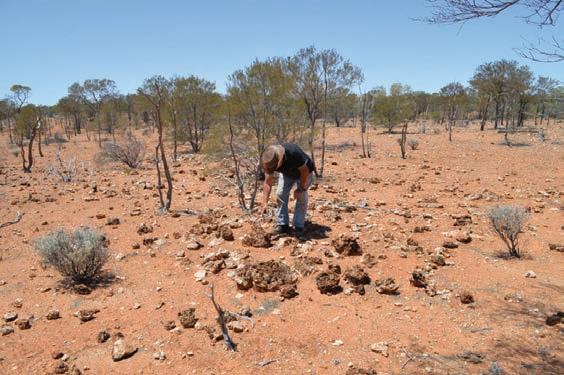
Three tenements with two granted and one pending application are situated on the Main Road from Carnarvon to Meekatharra. This includes mostly sealed bitumen to Meekatharra, a mostly sealed main road to Geraldton port, while station tracks just north of the Gascoyne River give access to the northern tenement areas.
This is a greenfield site surrounded by companies as Kingfisher Mining, PVW Resources and Krakatoa Resources, as well as Odessa Minerals and others who have reported significant finds on their tenements.

State and Federal Governments offer assistance including drilling subsidies. Russell Mining feels that a company with sufficient size to enable drilling to the basement of the underlying Paleo Valley and who is experienced with intrusive such as carbonatites would suit the company’s needs in helping explore this exciting project.
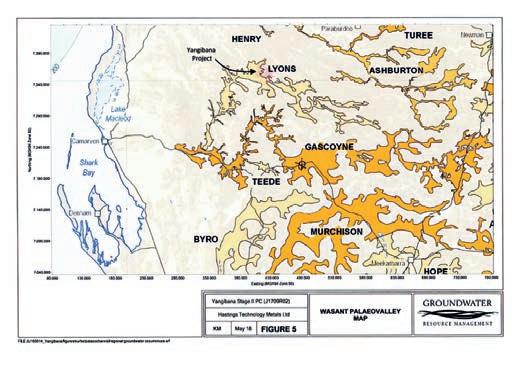 Victor
Victor
K Russell. Director.
ENQUIRES TO Victor Russell at kimvickr@gmail.com
SUBMISSIONS TO Aiden Rando
cosmetics and nanotechnology.
The company will proceed with early-stage site preparation for Stage 1A construction of Great White in the coming months, with further funding to be raised to support this.
With international buyers lining up, and the last of its regulatory approvals in place, Andromeda’s Great White project is set to make a major splash in the market.
There’s plenty of work still to be done, but Andromeda has plenty of reasons to celebrate its achievements so far, paving the way for a halloysite-kaolin industry to be established in Australia for the first time.
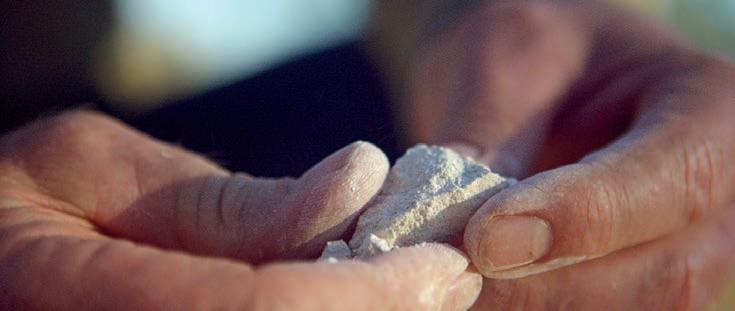
AUSTRALIAN RESOURCES & INVESTMENT
Andromeda is looking to become Australia’s first halloysite-kaolin producer.
The Directors of Russell Mining are seeking expressions of interest for their Landor Project in the Gascoyne Province,
– 25 –
A near-term gold producer steeped in history
Australian Resources & Investment showcases the emerging Adelong gold project and its near-term potential to join the NSW gold-producing ranks.
Ever since Adelong Gold acquired its namesake gold project in New South Wales in May 2020, the company has been advancing the asset on a number of fronts.
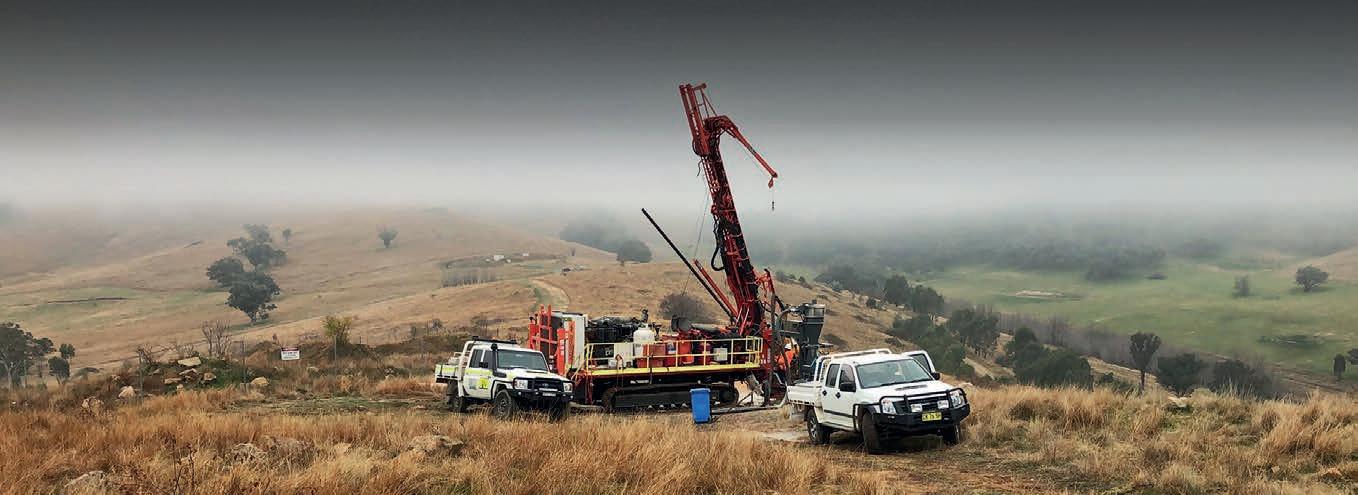
The Adelong gold project produced for a short period of time before the company acquired it, however as Adelong managing director Peter Mitchell suggested, there were some issues with the previous operation.
“Adelong had not been developed properly with the right scale, equipment and mine plan so the project needed to be revamped,” he told Australian Resources & Investment
“It didn’t mean that the project itself shouldn’t work. The metallurgy was really good – every record showed it was getting plus-95-per-cent recoveries of gold in various process technologies. So we knew we could do it better, but we had to clean the slate and rethink how best to develop the project.”
In restrategising the Adelong gold project, Adelong Gold looked at the project’s economic potential, which supported the need for greater scale and resource expansion.
“We’ve built up a bigger resource base, larger-scale production, and designed this around what would be economic,” Mitchell said.
This saw Adelong Gold reconsider the project’s processing and tailings strategy,
with the company’s sights set on maximising its mining footprint to enable more deposits and more ore streams.
Adelong’s flagship deposit, Challenger, was mined by the previous owner and has an active mining permit in place. Elsewhere, Adelong is represented by the Currajong and Caledonian deposits, as well as several other emerging prospects, with the company holding exploration permits spanning 70 square kilometres.
Since acquiring Adelong, Adelong Gold has increased the resources and average grade by 35 per cent and 18 per cent, respectively. The project has a current JORC resource of 1.55 million tonnes at 3.41 grams per tonne (g/t) gold, which equates to 169,700 ounces of gold.
Mitchell said in order to accommodate greater scale at Adelong, the company is exploring the option of building a 240,000tonne processing plant, however not all of this capacity may be used initially.
“Initially, we were looking to start it (the processing plant) on one shift,” he said. “In other words, we’re planning to treat 120,000 tonnes the first year, which is what the development consent allows us to do.
“Then we plan to expand the throughput when we incorporate our other resources with approvals.”
Adelong Gold released an updated scoping study in late October 2022, which demonstrated $11.9 million of initial capital costs for a five-year mine life, with the potential to produce 81,082 ounces.
This would generate net cash flow of $69.2 million at an internal rate of return (IRR) of 72 per cent when all capital and operational expenditure is considered.
Perhaps most significantly given Adelong’s scale potential, the updated scoping study only considered 55 per cent of the JORC resource, highlighting the untapped upside of the project.
Mitchell said Adelong has “all the makings of a good mine” and that the immediate focus would be continued exploration and bolstering the resource.
“We’re satisfied that we can do it, so we’re now looking at exploration,” he said. “Anything we find now will just go straight to the bottom line – with the last resource we added $17 million. So if we get a few of those, then we’ve got a really solid project.”
Adelong commenced a drill program at its Gibraltar prospect in March, which is following up a successful drill program completed in October 2022.
Significant assays from the October program included 3m at 12.57g/t gold from 20m, including 1m at 34.6g/t, and 1m at 18.55g/t gold from 78m at drill hole 3DGIB007.
– 26 –
GOLD
Adelong Gold is developing a range of prospects at its namesake project, including Challenger, Gibraltor and Caledonian.
Drill hole 3DGIB008 delivered 6m at 2.79g/t gold from 90m, including 1m at 8.58g/t.
Mitchell said Gibraltar, which has the potential of a porphyry system, is one of Adelong’s most exciting prospects.
“Drilling has shown, for the first time, very wide zones of pervasive mineralisation indicating the potential of the Gibraltar area to generate a large tonnage resource,” he said. “It has the sniff of a porphyry system and part of our March program is to drill some holes deeper below where we drilled last time and see what it looks like.
“When I first looked at Gibraltar and started drilling it, I was looking for a 50-60m open cut mine. But now that we’ve got some good results, we’re going to drill a couple of deeper holes to see what the trend is. If it’s really good, we’ll stick one hole below it all.”
Gibraltar, which has produced 140,000 ounces of gold in the past, not only forms part of today’s Adelong project, but also forms part of the broader Adelong Goldfield which has historically produced more than 800,000 ounces.
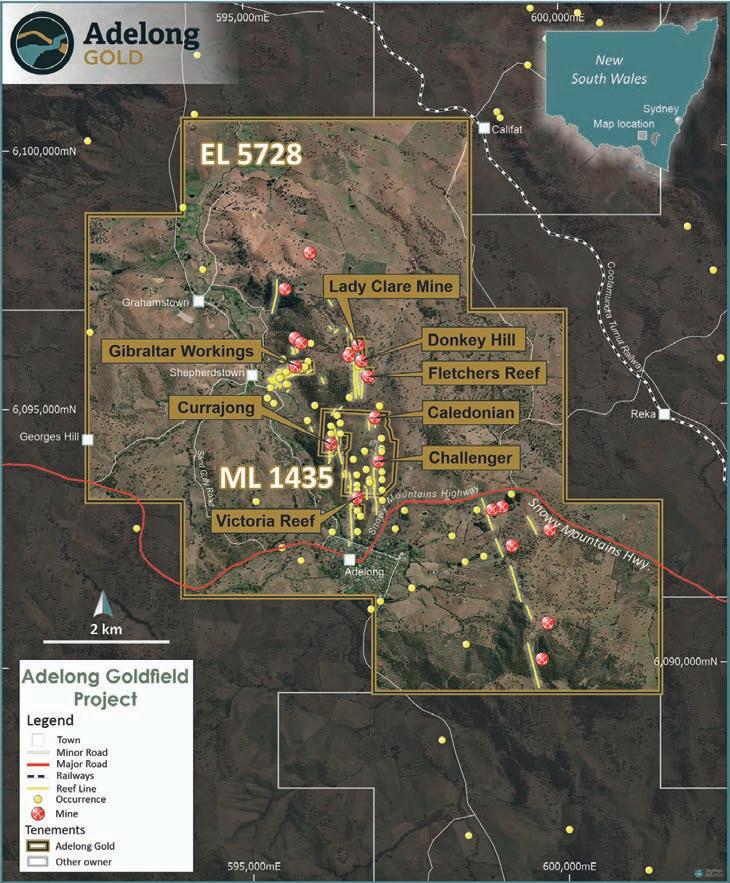
“Historically, this area has been mined in the 19th and 20th centuries at a grade of 31 grams per tonne – over one ounce to the ton,” he said. “But we can mine it down to two, three or four grams per tonne. Our economic cut off is one gram per tonne.
“We can do things the old timers could never do and there are a lot of resources that have never been mined because they could not deliver the high grades required to be economic. We’ve got three-and-a-half kilometres of strike of a mineralised body which has historically only produced 6000 ounces and largely remains untested.
“Some drilling done in the southern part (the Sawpit deposit) of Adelong is showing good widths and grade. These are the kinds of targets we’ve got for going back and really opening up this area for more potential.”
An expanding Adelong gold project means Adelong Gold will require further approvals to mine the additional deposits. The company is in communication with the local councillors about Adelong Gold’s longterm mining prospects and has support from the local community for the project.
As Adelong Gold continues to understand the scale of its Adelong gold project, it can have confidence in the fact it has built the foundations to be a near-term gold producer. And with a passionate and committed board of directors leading the way, Adelong Gold is setting itself up for an exciting future.
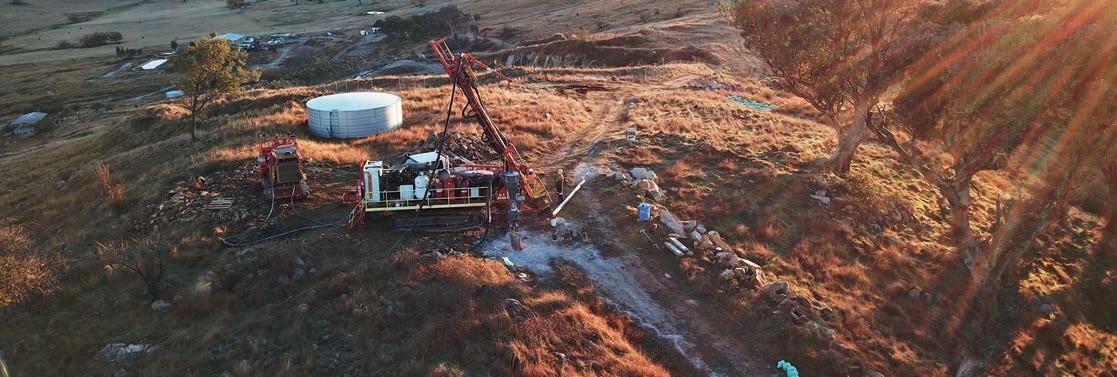
– 27 –AUSTRALIAN RESOURCES & INVESTMENT
The Adelong gold project is located near the town of Adelong in NSW.
Adelong Gold’s exploration and mining licences.
An early mover in north-east Tasmania
Australian Resources & Investment sat down with Flynn Gold, an ASXlisted company with a suite of exciting projects in the emerging gold province of north-east Tasmania.
Flynn Gold has delivered significant exploration success at its gold projects in north-east Tasmania, highlighted by continuous high-grade assay results from the Trafalgar prospect at its Golden Ridge project.
Some of the most impressive results include 1.2m at 65 grams per tonne (g/t) gold from 57.5m, including 0.5m at 143g/t gold in drill hole TFDD003; and 1.25m at 106.6g/t gold from 119.8m, including 0.7m at 152.5g/t gold in drill hole TFDD005.
In January, Flynn Gold announced drill hole TFDD005B had intersected 14.7m at 5.5g/t gold from 109.4m, including 0.6m at 109g/t gold.
These results have marked the birth of a new gold prospect not only significant to Flynn Gold but to the broader Tasmanian mining industry. And it was something Flynn Gold technical director Sam Garrett and exploration manager Sean Westbrook anticipated when they first pulled together the company’s north-east-Tasmanian assets.
“Sam and Sean identified opportunities which were overlooked as far as gold in north-east Tasmania goes,” Flynn Gold chief executive officer Neil Marston told Australian Resources & Investment.
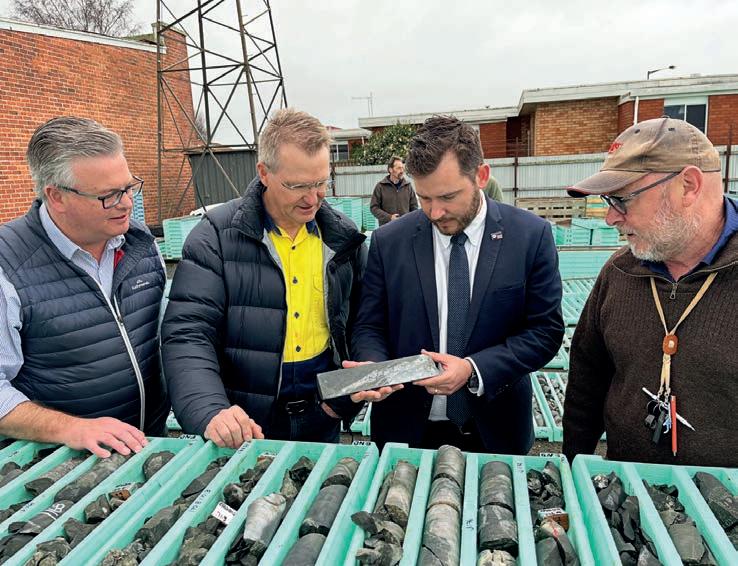
“Sam and Sean are both Tasmanian locals – they were raised in Tasmania and have family there – so they know the background of that part of the world pretty well, and particularly after the discovery of high-grade gold in Victoria around places like Fosterville, there was a lot of encouragement to go and secure old goldfields in north-east Tasmania.”
This part of Tasmania holds a number of geological similarities with Victoria, both hosting orogenic and intrusion-related gold systems (IRGS). Victoria has several operating gold mines, including Fosterville, Costerfield and Stawell, but there are no gold operations up and running in north-east Tasmania. This is not reflective of the endowment, with north-east Tasmania still underexplored.
In fact, while $222 million was spent on exploration in the Victorian goldfields in 2021–22, approximately $32.8 million was spent on exploration in Tasmania over this period, with most of this spent on areas outside of the north-eastern part of the state.
Marston said through Garrett and Westbrook’s foresight, Flynn Gold has established an early-mover advantage in north-east Tasmania, with a 1134-squarekilometre landholding at its disposal.
“The most important thing is we’ve picked up most of the gold prospective tenure in that part of north-east Tasmania east of the Tamar River,” he said.
“Apart from some ground around the Mathinna goldfields, we’ve certainly got the rest of the ground north and south of that which has historically produced gold.
“This has given us time to gain an understanding of what the geological setting in that area is, certainly up in Portland where we were drilling initially – that looks similar to Victorian goldfields-style folding in the rocks.
“At Golden Ridge, we think we’re onto an intrusive-related gold system. That’s similar to what’s been occurring in the eastern part of the Melbourne Zone within the Victorian goldfields.”
While Flynn’s Portland gold project has signs of high-grade Fosterville-style mineralisation and has more than 20km of strike potential, Golden Ridge has shown the potential to host a large gold resource over several deposits.
Marston said as the company continues to realise the potential of its tenure, it keeps a close eye on developments in Victorian gold exploration to identify any analogies. One key takeaway is that much less deep drilling has been completed in Tasmania than Victoria.
And with deep drilling proving successful in Victoria – resulting in frequent highergrade intersections – Marston said this could be a strategy Flynn Gold employs.
– 28 –GOLD
Tasmanian Resources Minister Felix Ellis inspects drill core with the Flynn Gold team.
Extensive gold anomalism has been identified over 8km of strike within a granodiorite-hornfels contact zone at Golden Ridge, which remains largely unexplored.
“The Golden Ridge area is still untested to a large extent,” Marston said.
“We initially came up with some higher-grade intervals at the Brilliant prospect and have extended the gold mineralisation there.
“The next thing for us was to see if we could determine whether there was going to be some good mineralisation at the nearby Trafalgar prospect. We were testing an area where only one diamond drill hole had been drilled historically which had intersected some interesting gold numbers towards the bottom of that hole.
“Our first hole TFDD002 intersected multiple zones of veining which was very encouraging. We then expanded the program, looking to see if this mineralisation extended over 200m or more of strike length.”
Marston said this strategy began with drill holes TFDD003 and TFDD004, which drilled to the west and detected some very highgrade mineralisation, before TFDD005, which drilled 100m to the east, delivered the highgrade results Flynn Gold was hoping for.
“It really excited us when we were seeing grades up to 152 grams per tonne over 0.7 metres,” he said. “This is certainly confirming the overall potential of the area.
“We also did some RC (reverse circulation) drilling last year – a dozen holes for about 1400 metres over three prospect areas which was targeting some soil or rock chip sampling that looked interesting. We had some success on each of those targets as well, which is a very good sign.”
Marston said the RC drilling to date had confirmed the 8km of strike length identified at Golden Ridge and suggested that a campstyle gold system over this extent could contain significant gold mineralisation.
“We’ve been really encouraged that the work to date has validated the original idea and we now need to do more work around where we’re having some success at the moment, as well as testing some other areas of potential,” Marston said.
“It’s multi-faceted program going forward at Golden Ridge.”
In March, Flynn Gold announced it had raised $3.7 million via a $1.3 million placement in December 2022 and a $2.4 million entitlement offer in February. The company’s cash at bank at the end of February was $5.5 million.
Marston said this puts Flynn Gold in a strong position ahead of its Phase 2 drill program at Trafalgar.
“The company is now fully funded for its upcoming exploration programs, with the high-priority Phase 2 drilling at the Trafalgar prospect expected to commence within two weeks,” he said in a March ASX announcement.

“A short diamond drilling program at the Portland project is already underway to test the Popes prospect before a rig heads back to Trafalgar.
“Processing of core from Phase 1 drilling at Trafalgar is progressing well with several batches of samples submitted to the laboratory, meaning further drilling results are still to come.”
Through a multi-faceted exploration program at Golden Ridge and diamond drilling at Portland, as well as its emerging projects in the Pilbara region of WA – which have shown lithium potential – there’s plenty to be excited about at Flynn Gold in 2023 and beyond.
Investors can expect a frequent stream of announcements and plenty more high-grade drill results as Flynn capitalises on its early-mover advantage in north-east Tasmania.
– 29 –
AUSTRALIAN RESOURCES & INVESTMENT
Drilling at Flynn Gold’s Golden Ridge project.
New era for tailings management
SRK Consulting senior engineer Heather Thomson believes the Global Industry Standard on Tailings Management (GISTM) will aid transparency and stakeholder confidence in tailings storage facilities worldwide.
But the magnitude of this change will also create significant extra compliance and costs for companies that adopt the GISTM (the Standard).
Moreover, the publication of results from external audits on conformance with the Standard could fuel community and investor activism against some mining companies that cannot meet the new tailings Standard in time, or choose not to adopt it.
Members of the International Council on Mining and Metals (ICMM) have until August 2023 to conform to GISTM for tailings facilities with ‘extreme’ or ‘very high’ potential consequences. All other tailings facilities have until 2025 to conform.
“GISTM is a landmark change for tailings management,” Thomson said.
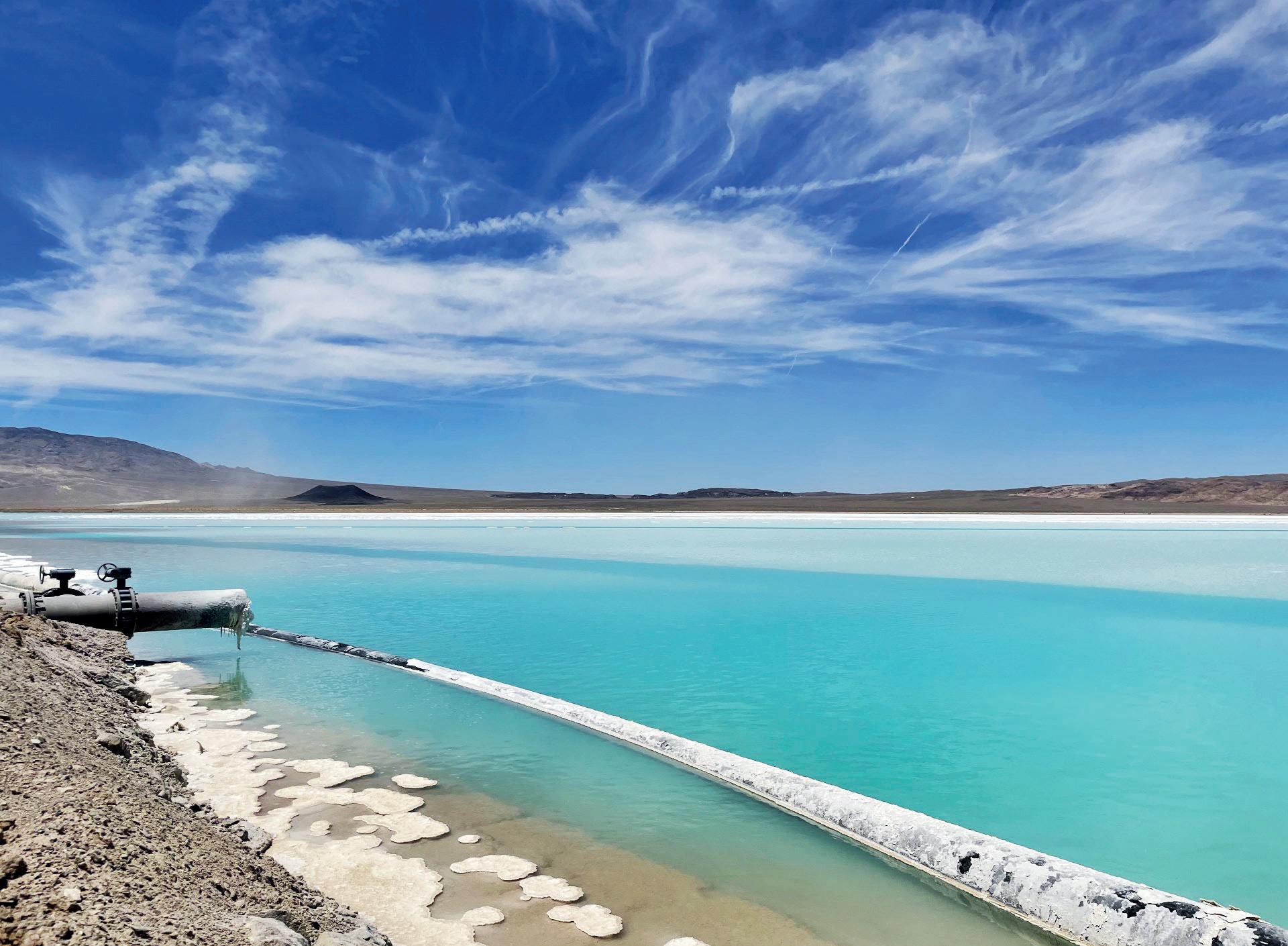
“For the first time, we will have extensive global data on tailings facilities – and a comprehensive set of principles for tailings compliance. It’s a positive change for the mining industry.”
Tailings dams are embankments built near mines to store mining waste in liquid and solid form. The stability of these dams – during the mine’s life and long after its closure – is vital for the safety of nearby communities and flora and fauna.
Thomson, a civil engineer, specialises in the design, construction, operation and closure of tailings storage facilities (TSFs). She has worked on TSF projects worldwide, from Australia, to Papua New Guinea and Brazil, and contributed to the Standard’s consultation process.
Thomson said mining companies must be well prepared for the change and have the right people in the right positions. The Standard requires that companies designate an engineer of record and an accountable executive for the TSF. They must also commission an independent firm to review the company’s TSF compliance.
“Conformance against the Standard requires years of upfront work and significant ongoing self-assessment,” Thomson said.
“Companies with tailings facilities that haven’t started on this work are taking a risk. It’s not something that can be done quickly given the amount of work involved, at a time of shortages in experienced TSF engineers.”
FAST PROGRESS
Change has occurred quickly. In August 2020, the ICMM, the United Nations Environment Programme, and Principles for Responsible Investment launched GISTM.
Their aim was to set a global benchmark for strong environmental, social and technical outcomes from tailings management. The ultimate goal: zero harm to communities and the environment from tailings facilities worldwide.
The Standard was motivated by the catastrophic tailings dam collapse at Vale’s Córrego de Feijão mine in Brazil in 2019.
– 30 –ESG
Mining companies must be well prepared for changes in tailings compliance and reporting, which has evolved with the introduction of the GISTM.
There is a belief the GISTM will aid transparency and stakeholder confidence in tailings storage facilities worldwide.
This human and environmental tragedy triggered action to enhance the safety of tailings facilities worldwide. The disaster followed a previous tailings dam collapse near Mariana in Brazil.
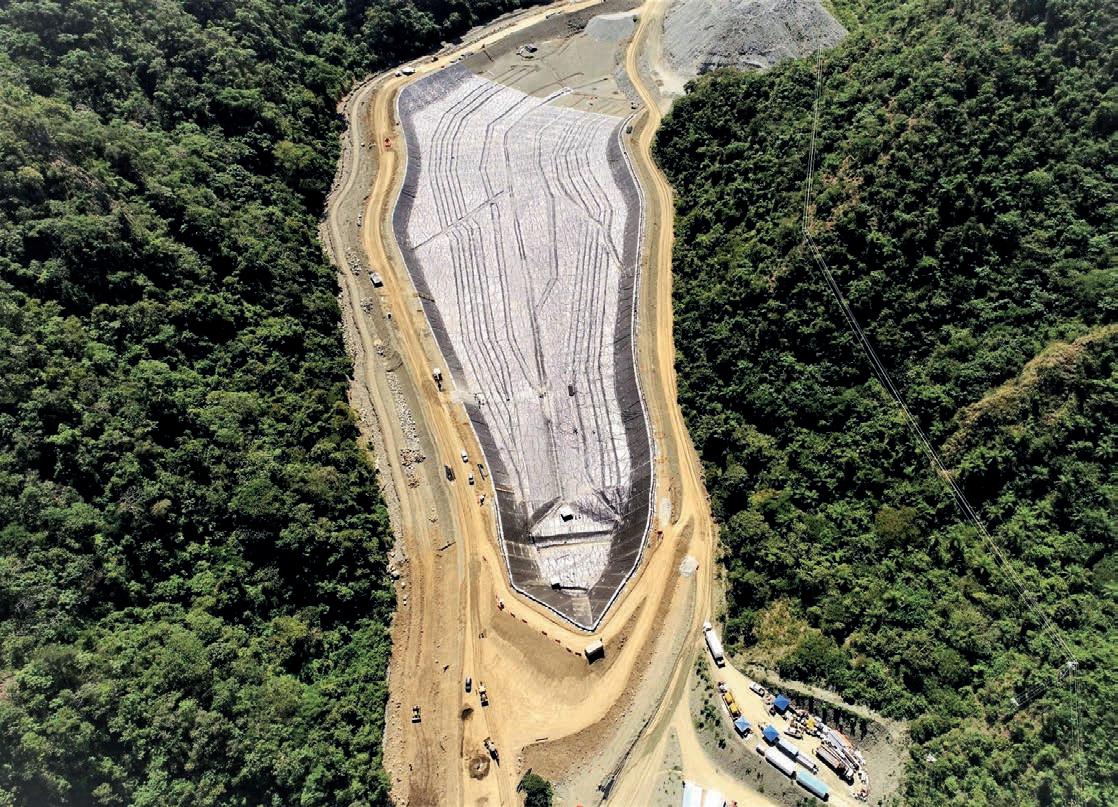
GISTM is a set of 15 principles that include 77 individual requirements for tailings facilities. Operators conduct self assessments against the requirements, with a third party auditing the company’s conformance. The results will then be published.
Thomson said the Standard has been widely adopted.
“Institutional investors have been actively voting against (the re-election) of chairpersons of companies that have not committed to at least review the Standard, with a view to implementing it,” she said.
The Church of England Pensions Board and Swedish National Pensions Funds’ Council on Ethics led the Investor Mining and Tailings Safety Initiative (that was responsible for GISTM). Funds with
more than $US13 trillion in assets under management support the initiative.
Thomson said the message is clear for listed mining companies that want to access this capital pool.
“They will have to adopt and conform to the Standard for their tailings facilities, report the results upfront and on an ongoing basis, and address any gaps. These aspects will enable greater external scrutiny of tailings facilities,” she said.
CONSEQUENCE VERSUS RISK
In 2019, the initiative asked 727 publicly-listed mining companies for detailed disclosures on their tailings storage facilities (TSFs). So far, 310 mining operators with a combined 1862 TSFs (across 761 sites) have provided information.
Thomson’s analysis of this preliminary data has valuable insights. Australia has 321 TSFs, only 18 per cent of which have been closed. About half of Australia’s TSFs are in Western Australia.
Exactly half of all TSFs in Australia are upstream or centreline raised facilities.
– 31 –AUSTRALIAN RESOURCES & INVESTMENT
For the first time, we will have extensive global data on tailings facilities – and a comprehensive set of principles for tailings compliance.
Tailings dams are embankments built near mines to store mining waste in liquid and solid form.
Upstream TSFs have been successfully used for decades, but require greater ongoing scrutiny and face growing opposition overseas. Brazil has banned upstream TSFs.
Thomson found Australian TSFs have a combined capacity of five billion cubic metres.
“Our country has a very large amount of waste stored at TSFs, of which about fourfifths are active facilities. Some Australian TSFs were constructed decades ago,” she said.
Thomson said Australia compares strongly in international comparison on TSFs.
“Our mining industry has benefited from high TSF design standards and monitoring,” she said.

“Also, our TSFs are typically in remote areas that pose less risk to surrounding communities, compared to many TSFs overseas.”
Thomson holds concern for public disclosures related to GISTM’s decision to classify TSFs through “consequence” of a potential failure rather than “risk”. She used an analogy in the property industry to describe the differences.
“The risk of a large building in a CBD falling down might be infinitesimal. But the consequence of that building falling over could be hundreds of deaths and significant damage to the environment through dust and other waste pollution,” she said.
In mining, the danger is stakeholders focus on the headline consequences of potential TSF failures – and overlook the minute risk of that failure occurring.
“Even the slightest risk of TSF failure must be rigorously analysed, reported on
carefully and addressed on an ongoing basis,” Thomson said. “But we don’t want a situation where opponents of mining immediately pick up on extreme potential consequences of TSF failure and use it in campaigns to stop projects. We need a balanced assessment that considers the risk of TSF failure against its consequences.”
Thomson said care is needed in how mining companies report TSF information and how audit results are published. Principle 15 of the Standard requires companies to publicly disclose and provide information on a TSF to support public accountability.
TEN TIPS FOR BEST PRACTICE IN CONFORMING WITH GISTM
1. Start early: Conformance with GISTM is a multi-year project. Even Tailings Storage Facilities (TSFs) that are not classified as having ‘extreme’ or ‘very high’ potential consequences – the vast majority in Australia – have just over two years to conform with the Standard.
2. Engage the board: Directors should ask management for information on the company’s approach to the Standard and for regular updates. Boards should be alerted to any delays or the identification of significant conformance gaps.
3. External support: Larger mining companies typically use in-house resources to manage conformance against the Standard. Smaller companies might use external consultant firms that have extensive experience in TSFs and understand the Standard.
4. Form multidisciplinary teams: The Standard cuts across TSF design, construction and operation; mine closure planning and implementation; environmental engineering, community engagement; investor relations and corporate affairs. Ensure the company’s team addressing the Standard has wideranging skills.
5. Develop an action plan: Mining companies that are well-advanced on conforming to the Standard will recognise any compliance gaps and have a plan
“Additional data on TSF performance has long-term benefits for a range of mining stakeholders,” she said. “But it would be counterproductive if that data was used to scare communities where the risk of TSF failure in Australia is very low.”
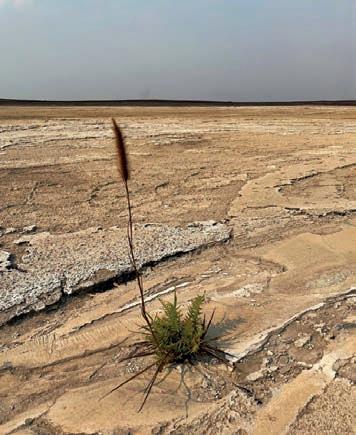
SRK Consulting is a leading, independent international consultancy supporting clients mainly in the earth and water resource industries. Its mining services range from exploration to mine closure. SRK experts are leaders in fields such as due diligence, technical studies, mine waste, permitting, and mine rehabilitation. Learn more about SRK Consulting at www.srk.com.
to address them. The goal should be to eliminate those gaps before the TSF audit.
6. Make appointments: The Standard requires mining companies to appoint an engineer of record for the TSF and have an accountable executive. An external auditor to test conformance also needs to be appointed.
7. Develop required reports: For example, the Standard requires a periodic dam safety review carried out by an independent qualified review engineer. A documented dam breach analysis for the tailings facility is also required.
8. Plan for ongoing work: It is expected that mining companies will have their TSF conformance regularly audited. GISTM conformance, reporting and communication will become a normal part of business for many mining companies.
9. Follow audit developments: It is not currently clear how the audit process will work or how, and when and where audit information will be published. Companies should ensure they are up-to-date with the latest announcements on how audits will be conducted – and how information from those audits must be delivered.
10. Communicate with stakeholders: Regular communication on this issue is vital. Consider how the company informs stakeholders, such as investors, on its progress with conformance to the Standards, any gaps identified and the operational response.
– 32 –FEATURED
The stability of tailings dams is vital for the safety of flora and fauna.



We are searching for Australia’s most outstanding mining and METs companies BRISBANE, 9 NOVEMBER 2023 PROSPECT AWARDS 2023 AUSTRALIAN MINING Australia’s premier Awards for the mining and minerals processing industry NOMINATIONS NOW OPEN FOR 2023 prospectawards.com.au PRESENTED BY SPONSORED BY
How Pilbara Minerals built a lithium empire
Pilbara Minerals is one of the best performing resources stocks in recent years, with its share price more than 1500 per cent higher than three years ago.
Sure, Pilbara was ready to capitalise on a reviving lithium market when stimulus returned in 2020, but the company had to weather a brittle downturn prior to that.
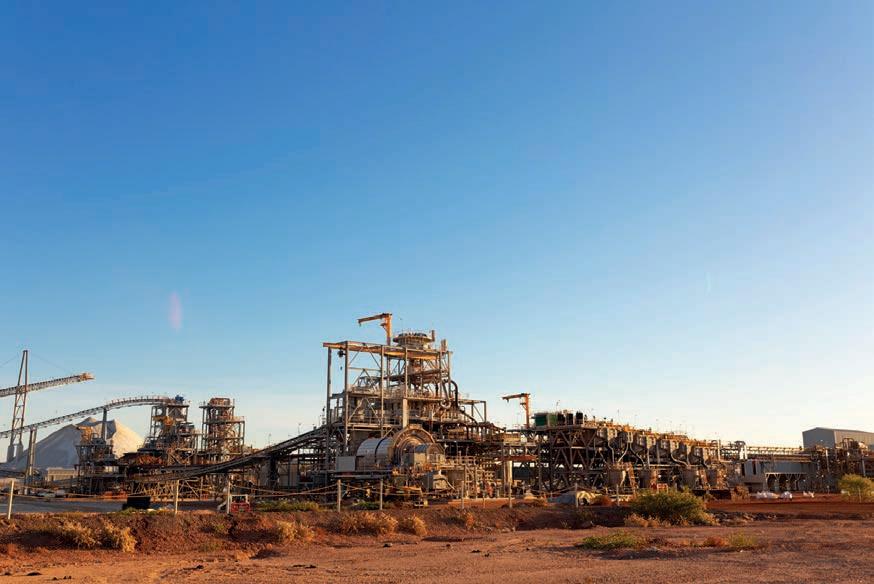
When Dale Henderson joined Pilbara Minerals in 2017 as its chief operating officer, the lithium outlook was strong amid a strengthening electric vehicle (EV) narrative.
For Henderson, “the sky looked bright, (and) I believed the story”.
“We were seeing the first uptick in lithium,” Henderson, who became Pilbara Minerals’ chief executive officer and managing director in June 2022, said at a recent Melbourne Mining Club luncheon. “New highs in lithium chemical pricing were struck in early 2018.”
But things quickly changed, and prices progressively cooled throughout the
remainder of 2018 and into 2019, coinciding with reduced demand from China – the world’s largest lithium-consuming nation.
“What happened there (with declining lithium prices) was demand retreating in China, because between the years of 2018 through to 2020, the global consumption was very much China and that … consumption was very much EV-subsidyfuelled,” Henderson said.
“But in early 2018, the Chinese Government started to pull back those subsidies and what played out from that point was this decline in pricing which was incredibly tough for the industry, and as pricing continued to decline, it turned out to be a fight for survival.”
The market began to turn in mid-2020, and this revival wasn’t just sparked by returning demand from China, but from other emerging jurisdictions.
In fact, several European nations introduced EV incentives in 2020, including likes of Germany, France, Spain and the UK.
“As a response to the economic impacts from COVID-19 across the globe, a lot of governments were looking to stimulate their economy and one of the levers they chose to pull was to pour funding into new industries of which EVs and EV subsidies were key beneficiaries,” Henderson said.
“Around about mid-2020, much of Europe started to deploy EV subsidies and shortly thereafter, Europe pound-for-pound was consuming more lithium than China, and then shortly thereafter (that), the US and North American subsets started to pick up, particularly following the appointment of the Biden Administration.
“What’s followed, particularly over the last 18 months, is increased demand translating to increased pricing.”
Henderson said not only are we seeing the emergence of new industries utilising lithium-ion technology, but we are also seeing the entrance of new jurisdictions outside of China.
“It (the lithium market) has moved from a China-based consumption model to a global consumption model,” he said.
“For the investors out there who worry, ‘Will 2019 or 2020 happen again?’, I can’t say no, I can’t say never, but … it’s a completely different world now.”
According to the International Energy Agency (IEA), EV sales accounted for 9 per cent of the global car market in 2021 – four times more than 2019 – and while China rose to 3.3 million EV sales in 2021, Europe increased by more than 65 per cent year-onyear to 2.3 million EV sales in 2021.
Now that we’re aware of the lithium story over the past few years, how did this translate to Pilbara Minerals’ performance, and how did the company weather the storm to be where it is today?
As early as 2013 – when Pilgangoora was an exploration project – its founding geologists, John Young and Neil Biddle, were initially on the hunt for tantalite.
This changed when Young attended the World Lithium Conference in 2015 and came
– 34 –LITHIUM
Charting the Pilbara Minerals story from a lithium minnow to an ASX 50 company.
Pilbara Minerals’ Pilgangoora lithium operation in Western Australia.
to understand lithium’s growing importance in the renewable energy sector.
When Pilbara Minerals had to resort to raising financing on the Nordic bond market in 2016, it highlighted Australia’s indifferent perception of lithium at the time.
Henderson joined the team in 2017, and the Pilgangoora mine was constructed just in time for the lithium downturn in 2018, or as Henderson calls it, “the lithium winter”.
“We went straight into this chapter of what we phrase, ‘the lithium winter’, and it was cold, bitter and it just kept going,” Henderson said. “It was a fight for survival, and for us it was all about balance sheet defence and being able to preserve the company as long as we could so that we could see through the winter and be on the other side.
“We had to save costs in every corner. What that looked like was two rounds of redundancies, standing down our mining contractor … for five months, who were fantastic in cooperating with what we needed to do, refinancing a senior debt facility, and the deployment of a moderated production strategy whereby we turned on the processing plant whenever we received a customer order.
“A lot of tough decisions had to be made and a big credit to the board of Pilbara Minerals for having the fortitude to make those tough decisions and having the
conviction to follow through and see it through to the other side.”
Henderson said Pilbara Minerals only operated for 30 per cent of the 2019–20 financial year (FY20), finished FY20 with a $100 million cash loss and still had the Nordic debt facility to pay off.
The company was hurting but soon enough, the tide would change.
“We managed to survive the storm and come late-2020, the ice was thawing, there were some signs of spring, and we were starting to have some confidence in the outlook,” Henderson said.
“Coincident with that time, the neighbouring operation, Altura, ran out of rope with their lenders so we acquired it. We had to max the credit card and the overdraft, but we got the deal done.
“Shortly thereafter, the market really began to turn, so from 2020, 2021, and onwards, we’ve been in this ramp-up mode effectively.”
As it targets 1 million tonnes per annum (Mtpa) of spodumene concentrate production, Pilbara Minerals continues to incrementally scale-up production at Pilgangoora. The company produced 162,151 tonnes of spodumene in the December quarter of 2022 (a 10 per cent increase on the quarter before) which is in line with 580,000tpa of spodumene production.
The company sold spodumene at $US5668 per tonne in the December quarter, a 33 per cent jump from the three months before. This enabled Pilbara Minerals to add $851.1 million to its cash balance, rising from $1.38 billion to $2.23 billion.
Pilbara Minerals is currently advancing its P680 expansion project, which will see it add another 100,000tpa of spodumene production to take its total production to 680,000tpa. The company recently awarded the P680 construction contract to Primero, which will involve the construction of primary rejection and crushing and ore sorting facilities to support this production uplift.
A final investment decision on the P1000 project to achieve the 1Mtpa production goal is planned for the March quarter of 2023.
Pilbara Minerals is a story of patience and persistence. As other companies folded amid the lithium downturn, Pilbara Minerals fought its way through and is now benefiting from its resolve.
Now an ASX 50 company, and with the world’s largest independent hard-rock lithium operation at its disposal, and further growth ahead, Pilbara Minerals is an inspiration for other lithium aspirants to follow.
Lithium has become a global industry and there is plenty of scope for other producers to join the party.
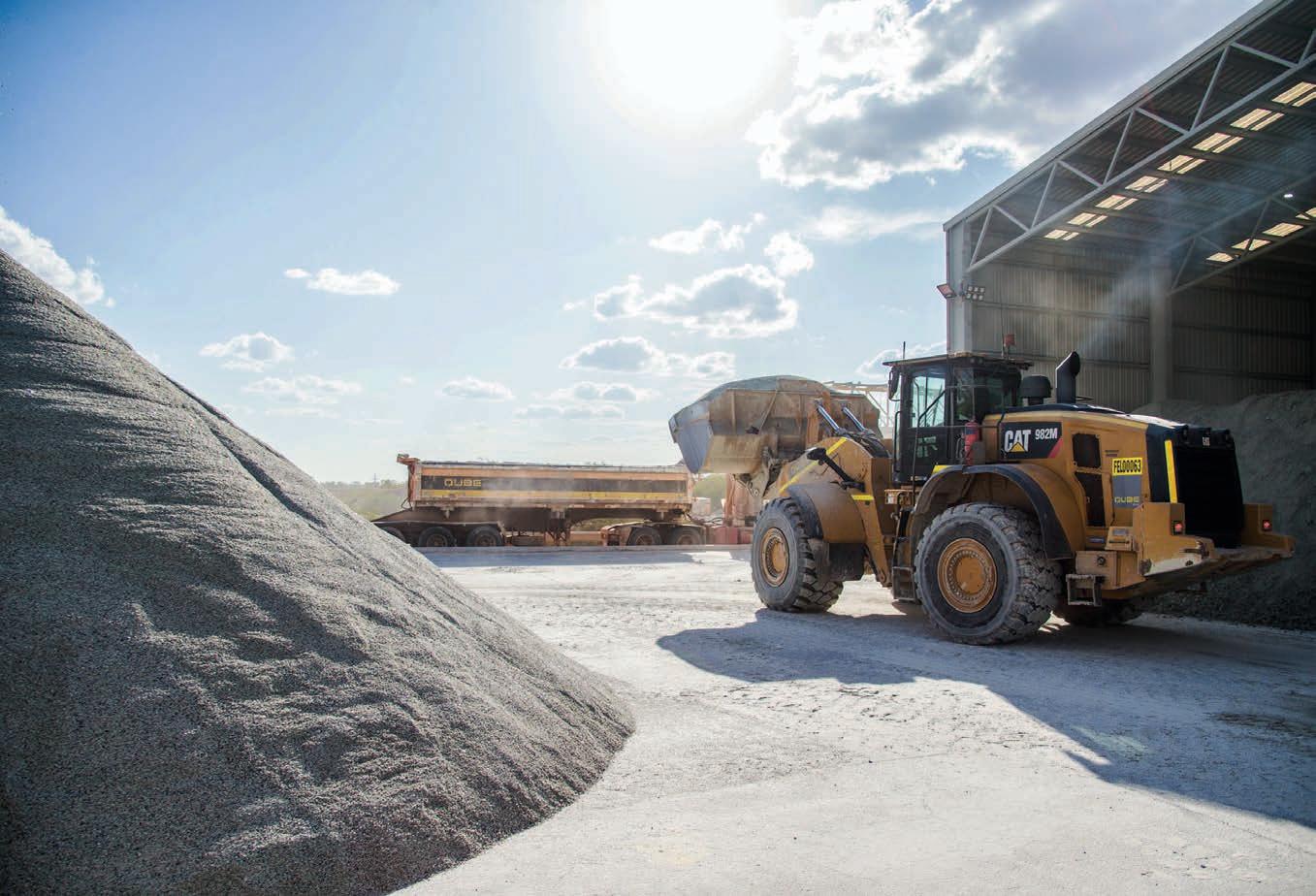
– 35 –AUSTRALIAN RESOURCES & INVESTMENT
Pilbara Minerals is targeting 1 million tonnes per annum of spodumene concentrate production.
Elevating Mincor
Gabrielle Iwanow took over as managing director of Mincor Resources in November 2022 and has enacted a wave of strategies to uplift the nickel miner.
David Southam elevated Mincor Resources from junior explorer to midtier nickel producer during his time as managing director of the company.
He departed Mincor in July 2022, leaving big shoes to fill for his successor, but the company has been in good hands.
A Fellow of the AusIMM, recently appointed Mincor boss Gabrielle Iwanow was named by Women in Mining UK as one of the top 100 Global Inspirational Women in Mining in 2020.
She had a distinguished 14-year career at Rio Tinto, working as general manager of the Paraburdoo iron ore operations in WA – where she led a 1200-person workforce – and in other senior executive roles.
Speaking with Australian Resources & Investment, Iwanow said she had a “really great career” at Rio Tinto but was looking for a fresh start. This led her to OZ Minerals, where she was general manager of the Prominent Hill operations in South Australia.
“The opportunity came about at OZ, and I hadn’t done underground before,” Iwanow
said. “I really liked the engagement with the team, so the more interactions I had with the people who worked there, the more I liked it.
“So I took the opportunity and I really enjoyed my time there. I feel like I’m a better operator as a result of my experience with the OZ team.”
It was the first half of 2022 when the Mincor opportunity came about, and Iwanow was selected for the role when Southam announced his resignation. She officially began as Mincor managing director and chief executive officer in November 2022.
When asked what drew her to Mincor, Iwanow said there were a couple of things that she liked about the opportunity.
“I really like that future-facing metals piece,” she said. “I like the fact that we work for a commodity that can play a meaningful role in the world’s decarbonisation.
“I really like the assets that we have. Kambalda is a well-known, Tier 1 nickel sulphide location and I like the fact that there’s not that many nickel sulphide options out there.
“I also like the fact that we’re producing and given our focus on future-facing metals, I feel like it’s a really attractive gateway for people to come into the industry and for those people who want to be part of the solution. For me, it opens up a whole new wave of talent out there who maybe weren’t attracted to our industry before.”
Iwanow has arrived at a time when Mincor is ramping up its Kambalda nickel operation in WA. Kambalda produced 1015 tonnes of nickel in concentrate in the December quarter of 2022 and remains on track to achieve annual production guidance of between 8000–10,000 tonnes for the 2022–23 financial year (FY23).
In the month of December, total ore movement increased by 69 per cent compared with November, which Mincor said marked a clear inflection point in the company’s second half ramp-up.
Mincor is bringing more stopes online at both Cassini and Northern Operations, which will result in improved ore grades and assist the ramp-up even further.
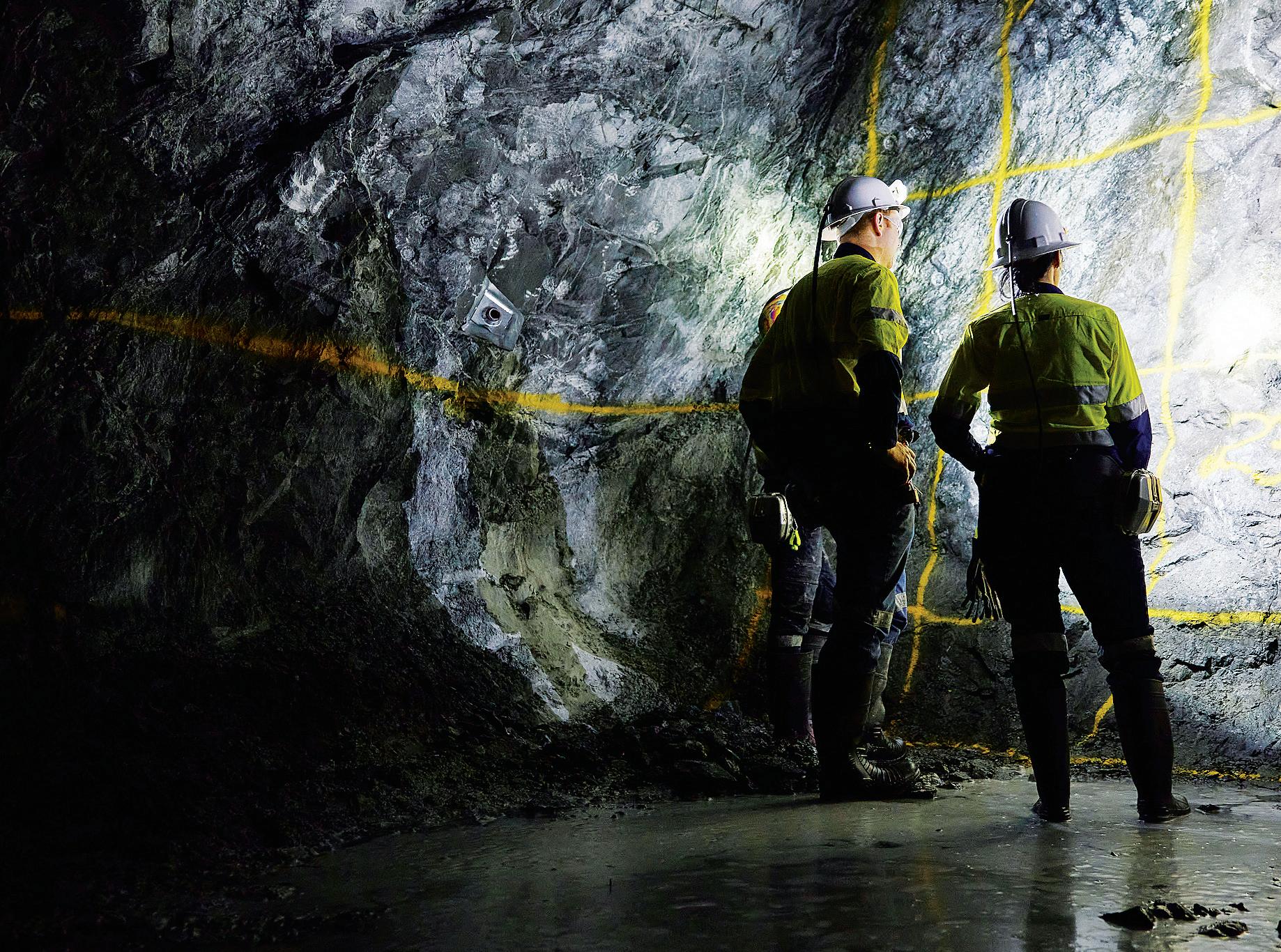
– 36 –
NICKEL
Underground at the Kambalda nickel operation in WA.
Iwanow said one of her immediate priorities at Mincor was to achieve the FY23 production guidance (8000–10,000 tonnes). FY23 is the first year Mincor has issued guidance.
“As part of this (achieving FY23 guidance), we are focused on de-risking the plan,” she said. “In my experience, ramp-ups really come down to quick execution and how quickly can you resolve the inevitable issues that come up in operations so you can get on and continue to meet your run rates.
“One of the things we’ve done at Mincor to de-risk our plan includes refreshing our contract with our underground mining partner, Pit ‘n’ Portal (an underground mining subsidiary of Emeco), to reflect some of the market conditions that have prevailed in WA and Australia more broadly. So some of the inflationary costs and labour costs that have really increased since COVID.
“This was an important part of removing the commercial distractions from being able to really focus on the safe movement of tonnes. So that’s been an important part of resetting our focus on the delivery aspect.”
Iwanow also highlighted the construction of Mincor’s southern operations accommodation village near the Cassini
deposit, which removes “an hour round trip”, reducing fatigue risk and boosting productivity outcomes.
Looking longer-term and Iwanow said she is focused on both organic and inorganic growth opportunities, which starts with maximising Kambalda’s existing potential.
“On the organic front, we’re looking at what’s within our existing tenements,” she said. “We’re doing a thorough exploration review at the minute which means we’re looking at the other things we might have on our tenements that we want to get after.
“You would have seen that we raised money ($60 million in December 2022) to bring forward development in the Golden Mile in that LN04a zone area, as well as the Cassini North channel. So we’ve brought forward those opportunities and I’m challenging my exploration team to say, ‘What else is there? What other opportunities might we have within our existing portfolio?’.”
Mincor completed a $60 million capital raise in January, through a share placement ($55 million) and share purchase plan ($5 million), both of which were strongly supported by shareholders.
Iwanow remained tight-lipped about Mincor’s inorganic growth plans, suggesting there’s “nothing to report on that front”. Nevertheless, Iwanow is “open to understanding what that might look like”.
She indicated that inorganic growth would consider “a broad range” of opportunities that are not just in the Kambalda region and “not just constrained to the one area”.
Mincor’s role in a renewable energy future cannot be understated. Australia’s current nickel producers are represented
by established operations such as Nickel West (BHP), Nova (IGO) and Murrin Murrin (Glencore), however emerging projects such as Kambalda are going to become increasingly critical.
According to the International Energy Association (IEA), in a scenario that meets the Paris Agreement goals of achieving a temperature increase of “well below” 2°C from pre-industrial levels by 2100, clean energy technologies will make up 60–70 per cent of nickel demand in the next two decades, taking over from stainless steel as the biggest nickel consumer.
Vale, the world’s largest nickel producer, said in September 2022 that it expected nickel demand to increase 44 per cent globally by 2030.
Iwanow said Mincor is uniquely placed in that it mines nickel sulphide, a high-grade product that’s more suitable for renewable technologies than a lower-grade nickel laterite.
“There’s not that many nickel sulphide deposits out there, so people will be looking to secure supply,” she said.

“Unlike a laterite, which has additional processing steps, they (nickel sulphides) will be a highly sought-after deposit, given how high they are in grade and their ability to be able to feed into a broader system, perhaps with less high-grade material.”
With the expansive potential of the Kambalda nickel operation, Mincor is strongly placed to be a key player in the world’s renewable energy transition.
And the company is in safe hands with Gabrielle Iwanow at the helm, with near-term and longer-term growth plans in full swing.

– 37 –
AUSTRALIAN RESOURCES & INVESTMENT
Mincor managing director Gabrielle Iwanow.
A rare earths project backed by centuries of experience
Russell Mining Pty Ltd is looking for a partner to help develop its Landor rare earths and critical minerals project in the Gascoyne region of WA. We take a closer look at the project’s history and potential.

The history of Russell Mining Pty Ltd harks back to the 1870s, when the grandfather of company director Victor K Russell, Captain Alfred Russell, was accumulating land in the Gascoyne region of Western Australia, just east of Carnarvon at Milli Milli.
More than a century of experience has inspired the development of Russell Mining’s Landor rare earths and critical minerals project, and now Victor is looking for a partner to help elevate Landor to its full potential.
Following Alfred’s untimely death, and after surviving World War I, Eric Russell MC returned to Australia in 1919 with a contract to revitalise the landholdings of his late father’s friend, R E Bush, in the upper Gascoyne.
The Landor and Mt Clere stations evolved from the separation of two million acres, and when the depression came, Eric diversified into mining focusing on gold, copper, lead and zinc in the West Kimberley.
The Napier Range lead mine was established after World War II with the family using army-deferred pay to start exporting lead-zinc from 1946.
After a price collapse in 1956, Victor left school to help support the family, working on family farms and the mine in the Kimberley where he established his own curiosity for mining and exploration.
“I would travel thousands of kilometres working on the mine and during that time, I spent a lot of time searching up and down the Napier Range for other minerals,” Victor told Australian Resources & Investment
In 1962, Victor, his father and brother Mark open cut the Napier Range mine and exported some 15,000 tonnes of raw ore to Europe averaging over 55 per cent lead until 1966
when the prices again collapsed and the mine was placed on care and maintenance.
After farming at Harvey River in southwest WA, Victor relocated to Landor and began prospecting for base metals in 1970.
In the years since Victor first pegged Landor – which is located approximately 280 kilometres east of Carnarvon – Russell Mining has established 225 square kilometres of ground that is prospective for rare earths and critical minerals such as gallium, tantalite, rubidium and rhodium.
As one of the first movers in the region, Victor said today’s Landor project is the culmination of more than 50 years of mining industry experience. And now other companies are following in his footsteps, with juniors Krakatoa Resources and Kingfisher Mining keenly exploring tenements adjacent to Landor.
Hastings Technology Metals’ Yangibana project, located 70 kilometres north-west of Landor, is on track to start producing rare earths in the second half of 2024.
– 38 –RARE EARTHS
The Landor rare earths and critical minerals project is located in the Gascoyne region of WA.
Victor said Landor “is in the centre” of a belt that spans the Gascoyne province and is associated with rare earths mineralisation. The project is also located on a main road.

“Landor is on the main road that connects Carnarvon to Meekatharra,” he said. “This road is bitumen, so there’s no access problems.
“For any company that wants to put a camp in, do any work or drive there, you can
get there with a two-wheel drive. It’s then easy for drilling, putting a mess in or getting fuel.”
As intrigue grows around the rare earths and critical minerals potential of the Gascoyne region, Landor has a bright future, but having survived blood cancer and at 82 years of age, Victor is looking for a partner to drill and develop the project to its full potential.
Landor is represented by three active exploration leases – E 09/2361, E 09/2369 and E 09/2691 – and is underlain by Archaean granites and gneisses with a degraded lateritic soil cover mostly within the northern part of the tenement.
Victor said exploration at Landor has shown the project to host rare earths and critical minerals within carbonatite.
“When I had surface sampling results analysed initially, I found what I was looking for, which was critical minerals and rare earths,” he said. “But last November I discovered that on the north side of the Gascoyne River within our tenements, we have carbonatite that runs over about 13-anda-half, 14 kilometres.”
Acid and magnetic testing have proven the presence of carbonatites at Landor, which are the world’s primary source of rare earth elements (REEs), niobium and zirconium.

Victor’s discovery of carbonatite followed extensive hand auger drilling to further understand the project’s unique mineralogy. He expects it to be a key selling point when Russell Mining finds its partner.
“This carbonatite is too big for our small company, so we’re looking for a company who can take it over and drill down
to basement because the leases are sitting over the top of a paleochannel – a huge channel that runs north and south rather than east and west.”
With the channel about 45m below surface, Victor said the project would suit a mining or exploration company that has the financial capacity to complete a thorough drill program.
“We would need a company who would be able to put a proper drilling program together, drill the carbonatite out and get down to basement to see what layers of REEs or critical minerals are in the clays that sit in the area we’ve already found,” he said.
“I’d really like to make sure the company just didn’t get involved because they are building up a portfolio rather than doing exploration. We are really looking for a company that has the financial strength to do a proper drilling program, but also has the expertise.”
Victor said he’d be asking the partner to pay at least $250,000 of cash upfront – which is similar to what Russell Mining has spent on the project – with Russell Mining to retain a percentage of the project.
As for Russell Mining’s long-term goals for Landor, Victor said if a mine was to be developed, he expected minerals to be processed in a similar fashion to Hastings’ Yangibana project.
“Because Yangibana are building a rare earths plant at Onslow, where they’ll cart refined concentrate over to the coast to treat, I would say that if we’ve got the mineral that we think we’ve got, we’ll be doing the same thing,” he said.
“Whether Hastings process our ore or not, I don’t know, but certainly the infrastructure is there to take the material across and process it in the same area.”
Victor said the Landor project also has road access to processing facilities further south at Mt Weld in Kalgoorlie.
“We’ve got bitumen coming down from Meekatharra and that goes through to Kalgoorlie as well,” he said. “So if Lynas is processing its material in Kalgoorlie, we could probably get our material down there as it’s bitumen all the way.
“The bitumen is huge in Western Australia, and you don’t have to maintain it because that’s taken care of by the Commonwealth or the state.”
Through centuries of mining and exploration, Russell Mining Pty Ltd knows the Gascoyne region like the back of its hand, with the Landor project just the latest chapter in this storied family journey.
– 39 –
AUSTRALIAN RESOURCES & INVESTMENT
Landor is prospective for rare earths and critical minerals such as gallium, tantalite, rubidium and rhodium.
Mine of the future
Deloitte’s 2023 Tracking the Trends report explores the most pressing issues affecting today’s global mining and metals industry. Australian Resources & Investment unpacks some key themes.
While the resources sector generates significant levels of Scope 1 and 2 greenhouse gas emissions, the materials the industry supplies mean it’s also central to the world’s decarbonisation efforts.
Deloitte Australia mining and metals leader Nicki Ivory said that while it’s critical mining companies focus on reducing their carbon footprint, it is also important to understand the central role the sector will play in the future.
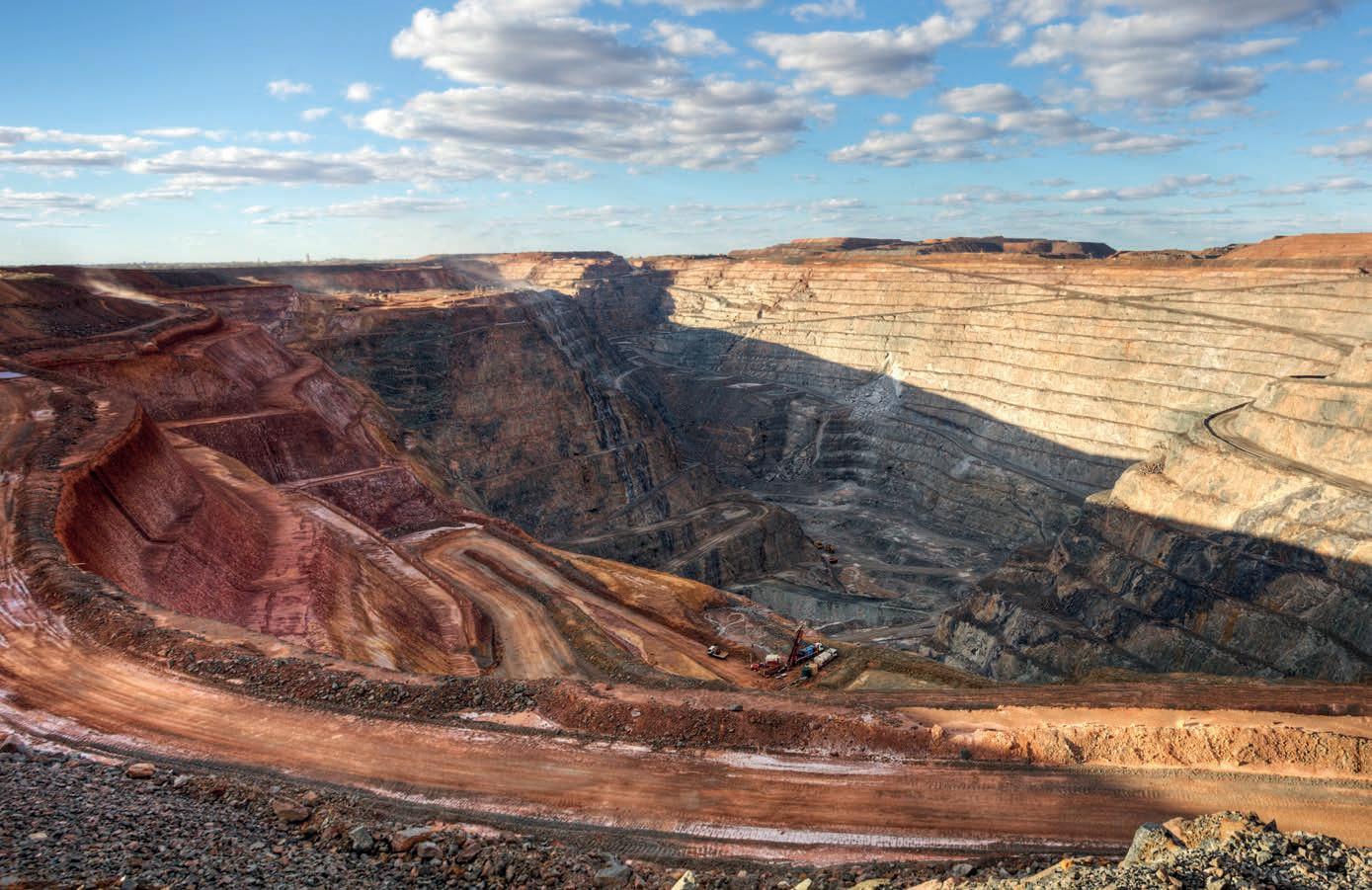
“We talk about carbon footprint, but there’s also the carbon handprint of mining,” Ivory told Australian Resources & Investment
“The footprint is our own emissions, and yes, the industry has to do a lot on that front because it’s a big emitter. But on the other hand, there needs to be this recognition that without mining the rest of the world can’t reduce its own footprint.
“The critical minerals (are) called that for a reason, as they will enable everyone – the whole world – to lower carbon emissions across the whole economy.”
The mining industry has a major role to play in driving down global carbon emissions, and what comes with the sector’s weight of responsibility is potential for world-leading change on an unparalleled scale.
In its 2023 Tracking the Trends report, Deloitte isn’t shy about labelling green energy as the key to future growth.
Deloitte highlights a list of trends showing the indispensable social, environmental, and economic value on which the mining and metals sector can deliver.
The first three of these trends deal almost exclusively with the industry’s relationship with the environment.
A STRATEGIC ADVANTAGE THROUGH NATURAL CAPITAL
Natural capital is the world’s stock of natural resources, including air, soil, water and all living things. Natural capital not only has an economic worth, but a fundamental value to humankind.
The concept is driving investor decisions and sentiment, as shareholders further understand the risk profile of the companies in which they are invested. It also underpins the general public’s perception of environmental performance in the resources sector.
As Deloitte climate and sustainability partner Michael Wood explained, the meaning of natural capital can be understood by considering the components of a mining tenement.
“If you draw the boundaries of a tenement, within that tenement, traditionally the only thing that’s really valued is the commodity in the ground,” he told Australian Resources & Investment
“What natural capital is doing is to say, within that tenement, you actually interact with a huge amount of systems – you interact with the atmosphere, you interact with the geosphere, which is the geology, you interact with oceans and other water bodies.
“Through the activity you’re doing to extract that commodity, you’re actually interacting with a whole lot of other systems, and those systems create value.”
According to the report, half of the world’s gross domestic product (GDP) is moderately or highly dependent on nature, without which the other half of GDP could not be sustained.
Deloitte sustainability strategist Celia Hayes said valuing natural capital is something the mining industry has been doing indirectly for years without realising it – it just hasn’t been doing it especially well.
“Laying out an investment plan for life of mine, funding mine closures and managing site rehabilitation are all instances of valuing or costing in natural capital,” she told Australian Resources & Investment.
– 40 –
INDUSTRY INSIGHT
“But there’s much more the industry could be doing to maximise natural capital, such as ensuring that they regenerate and positively impact the natural assets which they have stewardship over.”
Though not necessarily common, there are active examples of preserving natural capital in the industry, such as South32’s manganese operations at Groote Eylandt on the Gulf of Carpentaria. Hectares of natural bush need to be cleared in order to mine the NT site. South32 sends surveyors into the bush to flag key species, ensuring it has a clear understanding of the ecosystem in which it’s working. This enables the company to divert operations around habitats and other instances of natural capital where appropriate.
South32 also progressively rehabilitates the site, backfilling topsoil and seeding the ground in cooperation with Traditional Owners.
Wood said while investors are beginning to understand the weight of natural capital, “it’s still early days”, with many investors still realising the true impacts before converting that into exposures.
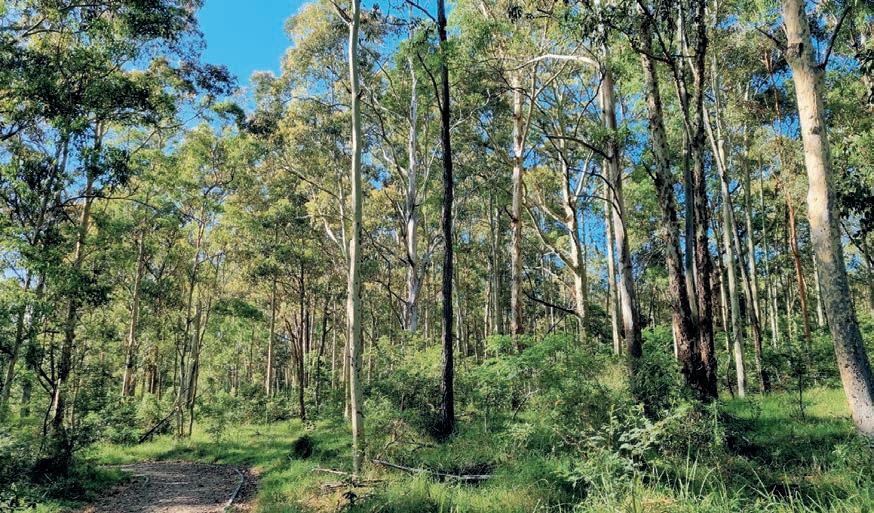
Ivory cited an annual letter from BlackRock chief executive officer (CEO) Larry Fink to demonstrate her point.
“Larry Fink, who leads BlackRock – the biggest investor in the world – he writes a letter to CEOs every year,” she said. “If you look back over the last five years, you can see that evolution of investor thinking around what to look for when you’re investing and how you manage some of these risks.
“He wrote a few years ago that climate risk is investment risk; I can see the point coming where natural capital risk is investment risk. That sustainability pathway is not just climate, and this has been started by the groundswell of society, but then picked up by some of these big investors who manage money on behalf of many, many people.”
Changes to the climate, as well as the inherent finitude of resources, will affect most mining and metals companies over the next decade, making the preservation of natural capital crucial for longevity.
Miners of the future, according to Deloitte experts, will be expected to provide value of a different kind, including social and environmental. This means not just mitigating, but creating positive impacts.
MINING’S ROLE IN A CIRCULAR ECONOMY
A traditional linear economy is one where materials are sourced, converted into products and – when consumers are finished – tossed away. According to Tracking the Trends, the intensification of climate change, environmental degradation, and widespread pollution are a product of a linear economy. But there are opportunities to change, which is where a circular economy comes in.
Wood explained in more detail.
“The principles of circularity consider the huge amount of value still left in a product that we’re not maximising,” he said.
“It’s about keeping those products in the cycle for longer and thinking about it at a systems level, where rather than those isolated components of the value chain being segmented, how can they interact together?
“And at what points can we design out waste and pollution? Or at what points can we keep those products in cycle at the highest value?
“Ultimately, it’s around regenerating those natural systems that support the circular economy.
“Whilst at face value, you might think that there’s an immediate threat to the sector, there’s actually way more opportunities than risk for the mining industry in a circular world.”
Tailings retreatment is one example of the circular economy in action in the mining industry, a practice Wood said would become more and more pertinent as mining inputs become more expensive.
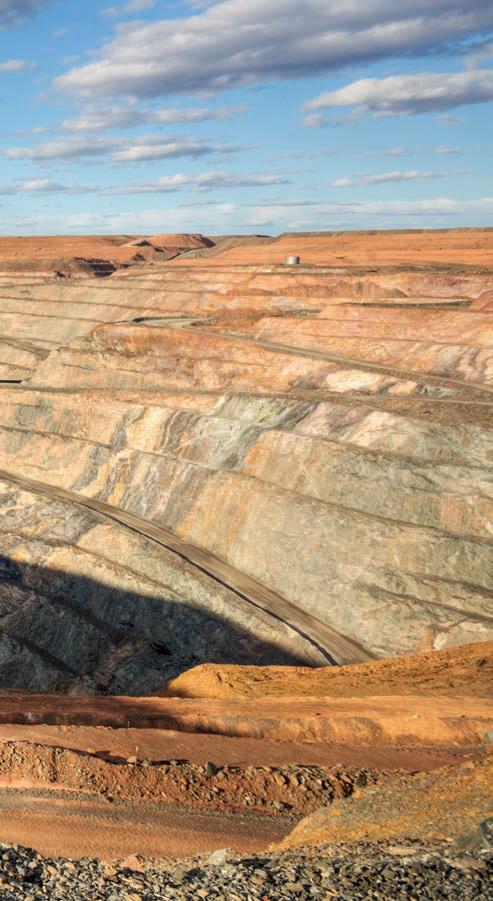
“Recovery has been around for years and as energy, as water, as other environmental aspects become more and more expensive, and deposits traditionally get harder to access, those ways of retrieving low-grade, lowconcentration metals from tailings will become attractive at some point in time,” he said.
Wood said in order for the mining industry to maximise opportunities that lie within a circular economy, it’s important to challenge the idea of ‘waste’.
“What is waste? It’s still useful, it just has to have the right environmental conditions to be useful. There’s a number of pressures that will force that, such as the cost of natural resources, to the cost of disposing natural resources,” he said.
“Reclaiming materials from tailings, reclaiming metals from urban environments, rather than (letting them) go to landfill, it’s just going to happen through natural pressures within the ecosystem.”
– 41 –
AUSTRALIAN RESOURCES & INVESTMENT
Given its materials are inherent to global decarbonisation, the mining industry has a unique opportunity to foster change.
Proactive mine rehabilitation is one way mining companies can value natural capital.
ASX-listed Neometals is championing new circular concepts, with lithium-ion battery recycling and vanadium recovery two of its innovations.

Through a 50:50 joint venture (JV) with Primobious GmbH, Neometals is commercialising a proprietary process for recovering nickel, cobalt and other valuable materials from spent lithium-ion batteries.
The company is also sole funding the evaluation of a potential 50:50 JV with Critical Metals to recover vanadium from processing by-products from leading steelmaker SSAB. Ivory said Neometals is a great example of a company focusing its business model on the circular economy.
“Their whole business premises on exactly this: how do we reduce reliance on traditional mining and support circular economy principles?” she said.
DRIVING DOWN EMBODIED CARBON IN METALS
The resource sector’s fundamental role as an extractor and processor of raw materials means its potential to lower carbon emissions across the broader economy outweighs its own footprint.
Scope 3 emissions are indirect emissions that are generated upstream and downstream across the value chain. These constitute up to 98 per cent of a company’s total greenhouse gas emissions.
Though miners have a great deal of control over the decarbonisation of their immediate operations, it’s much more difficult to enforce decarbonisation along the supply chain. It
involves companies reviewing their supply chains, picking strategic relationships with other businesses, and developing new technologies and processes where necessary.
Given the interconnectedness of a value chain, where the actions of one party have a direct or indirect effect on another party along the chain, companies are becoming more conscious of upstream and downstream behaviours.
“Customers care, customers of customers care, and they’re putting that upwards pressure on the supply chain to say, ‘hey, if you want to participate in our supply chain, if we’re providing net-zero commitments to the market, we can’t do that if our supply chain isn’t net-zero’,” Wood said.
“So that upwards pressure is coming, then companies are getting downwards pressure from policymakers wanting to take the pathway to net-zero. Then you’re getting the investor pressure as well. They’re the forces that are happening and from a company perspective, it’s around that traceability of product through the supply chain.
“There’s only a couple of ways you can do that – through chemical-tracing using technology and physically tracing the product through the value chain, and in some cases with a lot of metals, that’s very hard to do.
“So there’s a lot of work to do in that space, particularly when you’re providing product into markets that aren’t overly transparent about how that product is used or processed.”
– 42 –
INDUSTRY INSIGHT
Tailings retreatment is one way mining companies can rediscover value from waste.
That upwards pressure is coming, then companies are getting downwards pressure from policymakers wanting to take the pathway to net-zero. Then you’re getting the investor pressure as well.
One example of value-chain decarbonisation between two or more parties is ELYSIS, a JV between Rio Tinto and Alcoa, with support from other brands and government bodies.
ELYSIS utilises carbon-free smelting technology to produce aluminium, leading to zero greenhouse gas emissions. The smelting process instead releases pure oxygen.
Rio also has an ESG (environmental, social and governance) sustainability label called START, which utilises blockchain technology to provide full transparency and traceability for the aluminium it produces. In other words, downstream suppliers have access to ESGrelated information such as carbon footprint, water use, and so on.
Rio Tinto has utilised ELYSIS and START to create value opportunities for itself along the supply chain. In February this year, Rio signed a memorandum of understanding (MoU) with BMW Group, supplying its responsible aluminium to a vehicle production plant in the US.



The arrangement is projected to lower BMW’s aluminium-related carbon emissions by up to 70 per cent.
Also in February, Rio signed an agreement with Japanese conglomerate Marubeni Corporation which will see its responsible ELYSIS aluminium hit supply chains throughout Japan.
The shift to a sustainable, carbon-neutral future is inevitable, but more mining will be needed to facilitate this change.
By preserving natural capital, adopting circular strategies within their operations, and working to influence decarbonisation along the value chain, mining and metals companies can become the global leaders of this change, supporting the net-zero pursuit far and wide.
– 43 –AUSTRALIAN RESOURCES & INVESTMENT
WATER MANAGEMENT MADE EASIER 1800 813 677 www.truflopumps.com.au We build superior dewatering systems specific to your needs. Use our 30 years of industry experience to make your next water management project easier.
Deloitte climate and sustainability partner Michael Wood.
Instigating mining’s new frontier
Epiroc’s commitment to drive change in the mining industry is inspiring METS companies all across the world to join the evolution.
It may seem as if Epiroc has been increasingly active in its pursuit for inorganic growth in recent times, but acquisitions form part of a company vision that has been built over years, if not decades.
Epiroc has always been an industry forerunner in that the original equipment manufacturer (OEM) has never been afraid to explore and institute change.
Peter Strimaitis, Epiroc’s vice president of mergers and acquisitions – digital solutions, said that Epiroc aspires to be a “change driver”.
“You can have a few responses to upcoming change, you can be resistant to change, you can be brought along, you can have a passive acceptance, or you can be a change driver,” he told Australian Resources & Investment
“Epiroc is taking a position where we, along with our customers and business partners, are driving the transformation in
the mining and construction sectors and where we see transformation occurring in particular is in the area of automation, electrification and digitalisation.”
Epiroc has anticipated mining’s next evolution, where driverless drill rigs, carbon-neutral haul trucks and digitallyconnected mine sites are the way of the future. And the OEM is responding to the needs of its clients by initiating its own advancements, adding new capabilities and perspectives in the process.
Recent acquisitions include the addition of CR, an Australian-based provider of advanced ground engaging tools (GET) and associated digital solutions. CR’s GET solutions include cast lips, teeth, and protective shrouds installed on mining buckets and loaders that increase productivity and operational uptime. Its digital solutions include real-time GET loss detection and payload management systems, among other offerings.
Epiroc also recently completed its acquisition of Mernok Elektronik, a South African company which is advancing the safety capabilities of the mining sector through its collision avoidance and proximity detection technologies that are of the highest standard (EMESRT Level 9).
With these two acquisitions, Epiroc has bolstered its offering of consumables, and added another string to its safety and automation bow, enabling the OEM to support more client requirements and requests.
Strimaitis said Epiroc is committed to providing its clients with a full suite of solutions, an objective supported by the recent acquisition of Perth-based Remote Control Technologies (RCT).

“To demonstrate our commitment to providing all different types of solutions across a mixed fleet, I highlight our acquisition of RCT,” he said.
“RCT is a proven, OEM-agnostic, mixedfleet automation provider that provides a range of automation, remote control, machine protection and data management services. Epiroc has plenty of automation expertise which has been typically based around Epiroc machines, so bringing in RCT means we can provide a holistic solution to our clients.”
Epiroc’s inorganic growth strategy is also centred on partnerships, where two or more like-minded industry pioneers work together for the betterment of a client.
Strimaitis used the example of Epiroc’s shareholding and partnership with ASI Mining.
“We’ve been working together with ASI Mining to roll out an autonomous haulage system at the Roy Hill mine,” he said. “This doesn’t involve Epiroc equipment, we’re instead providing the autonomous platform to automate that mine.
“This is very different from the traditional view that each OEM sticks to its knitting, as it were, and just works on its
– 44 –MINING SERVICES
Epiroc recently acquired Remote Control Technologies, an OEM-agnostic, mixedfleet automation provider.
own equipment. The world’s moving and clients want a total solution.
“Sometimes in the past it was about us providing automation on top of, or as part of, or as an adjunct, to the supply of our equipment. Now, we’re looking at a digital solution in its own right.”
Strimaitis said Epiroc and ASI Mining’s joint project was an example of an automation solution in its own right.
“That’s the market and the industry starting to change,” he said. “And that change will keep on accelerating.
“Take our acquisition of Mernok, who do collision avoidance and proximity detection, which also complements our purchase of Mining Tag. These companies provide solutions not just for Epiroc equipment, but for all types of equipment.
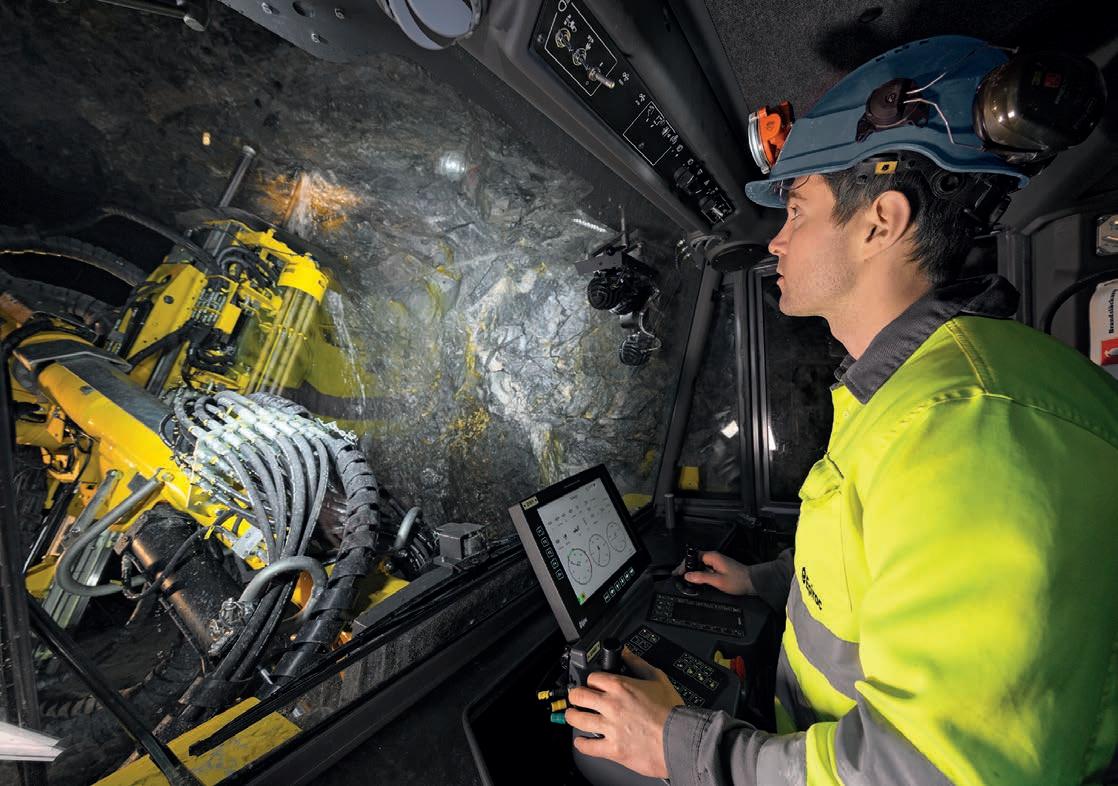
“This is where these digital solutions are becoming solutions in their own right, whereas in the past, they were almost like add-ons to an equipment purchase. Now you can start to see why Epiroc last year split out digital solutions into its own division.”
Prior to Epiroc creating its own standalone digital solutions division, the OEM’s digital focus formed part of its technology division.
Strimaitis said Epiroc’s digital solutions division is now about providing external support for its clients first and foremost, with many of the company’s recent acquisitions coming under this banner.
The core capabilities of the digital solutions division include automation, data integration platforms, situational awareness, collision avoidance, fleet management solutions, and machine performance and health data, to name a few. These solutions are suitable for both single and mixed fleets.
But Epiroc’s digital scope doesn’t stop there.
“A number of Epiroc’s digital solutions and products fit within the digital solutions division, but we also reach across other divisions to pull together their offerings that might fall under the digital banner,” Strimaitis said. “This is to ensure that a complete offering is provided to our clients.
“For example, we recently acquired CR, which provide ground engaging tools. CR fit into our tools and attachment division, but the company provides a number of its own digital solutions.
“If a client is seeking a broad portfolio of solutions, we can draw in the solutions
that might sit outside the digital solutions division, such as those offered by CR.”
Strimaitis, who himself has worked in the mining industry for decades, said he anticipated “step changes of improvements” in the sector in the near-term.
“The way we do mining and construction now, in 10 years’ time, it’s going to be radically different,” he said. “And everyone’s recognising that.
“There’s all kinds of different drivers for step changes and a lot of clients are wanting assistance and the level of assistance they’re looking for really depends on the client.
“You might have clients that are there with us trying to shape and drive change. Or you have clients that are keen to shape and drive change but are not sure how, and Epiroc can support them with that. And then there are clients that will adopt once they have seen proven solutions.”
In order for Epiroc to be able to support any situation or potential client scenario, the OEM is constantly adding more toolkits and options. Because only then can Epiroc be the true change driver it sets out to be.
– 45 –AUSTRALIAN RESOURCES & INVESTMENT
Epiroc established a standalone digital solutions division in 2022.
An evolution like never before
As unlikely as it may seem to most of us, according to UNICEF, half of the world’s population could be living in areas facing water scarcity by 2025, and more than 700 million people could be displaced by severe water scarcity by the end of the decade.
The planet may be made up of more water than land, but only an incredibly small portion of that water is accessible. In fact, more than 99 per cent of the earth’s water is unavailable to humans.
As a water-dependent sector, mining has a unique opportunity to support water conservation into the future, and with sustainable water management underpinning environmental, social and governance (ESG) obligations, it is increasingly vital that mining companies are being water smart.
For more than 100 years, Xylem and its brands have conquered water problems across the world, and in doing so the original equipment manufacturer (OEM) has become a trusted partner of the mining industry.
Matt Wessel, Xylem’s strategy, product marketing and engineering director –Australia and New Zealand, said that while the company has long been known for its dewatering solutions, its overall portfolio and offering is rapidly evolving.
“Historically, Xylem’s well known in the mining industry for our dewatering expertise and portfolio,” he told Australian Resources & Investment. “Our Flygt and Godwin pumps are what we’re most famous for in dewatering and slurry pumping.
“We also have a large portfolio that treats, tests and monitors water as well, and we are

definitely looking to have a bigger impact in the mining space solving challenges across the entire water cycle.”
Wessel said his team leads the way in developing end-to-end solutions for Xylem’s customers, which starts with delivering technical support and ideas, and incrementally optimising a solution to reflect the complexities of a mining operation.
“We do a lot of that (delivering solutions) across the water cycle in other industry segments and what the team is focused on at the moment is how do we package that for the robust environment of mining,” he said.
Wessel highlighted the emergence of electrification in surface dewatering as a key focus as the mining sector looks to exit diesel-driven equipment. Leveraging its Flygt brand – which has become a market leader
– 46 –MINING SERVICES
Xylem has helped the Australian mining industry solve water problems for over a century, but its next chapter could be its most exciting.
Xylem is focused on developing endto-end solutions for its customers.
in electric submersible dewatering pumps –Xylem is developing electric solutions for its historically diesel-driven Godwin brand.
Xylem is also ensuring its offerings are “digital-ready”.
“It’s important that we have connectivity across our portfolio that not only provides reliable and robust performance, but the data to help the customer optimise what they’re doing,” Wessel said.
Xylem’s traditional mechanical and rotating equipment for pumping and treatment is now fitted with technology that generates data and provides real-time insights into operational performance and where changes need to be made. This can be the difference between sustained uptime and a sudden mechanical failure.
As Xylem puts it, “to truly solve water, you must see it as clearly as possible”. Real-time data opens the door to operational clarity.
Achieving an end-to-end sustainable water management system is not only profitable for a mining operation, but it also enables miners to be effective stewards of their water resources.
“We can support mining operations in water management from their source water to when it is cleanly and safely returned to the environment,” Wessel said.
“We can do this by leveraging our broader Xylem portfolio that allows us to treat, test and measure water, providing the opportunity for complete end-to-end solutions. We couple this with the expertise of a great local team supporting our customers on the ground.”
Wessel said the uptake of Xylem’s sustainable water management solutions has increased in the ESG era, as major miners focus on becoming strong corporate citizens and responsible environmental stewards.
“As the mining industry scans the market, companies are seeing technology solutions like Xylem’s that enable them to be more sustainable in their water management and improve productivity and operational effectiveness at the same time,” Wessel said.
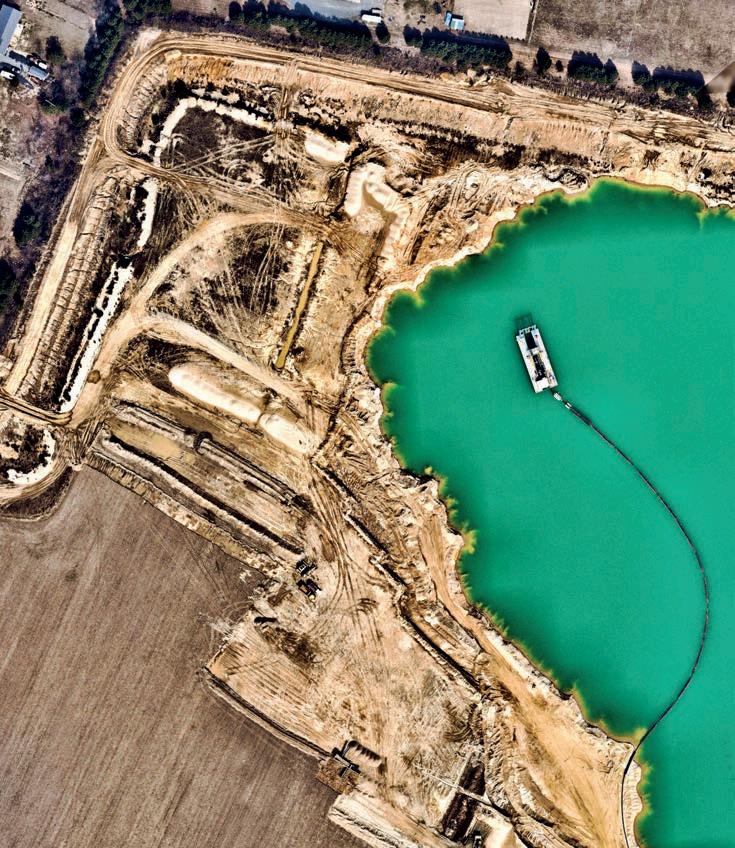
“Most of the initial efforts in these areas are quite targeted at individual problems rather than taking a more holistic view and understanding of the complete water cycle in mining.
“Having a technology platform that connects all their water assets allowing them to take a helicopter view of their complete water cycle will likely unlock further step changes in sustainable water management.”
Wessel said mining companies can go a step further and not only optimise their operations to support their social surrounds, but also actively engage with their local communities and understand their best interests.
“Miners can continue to work closely with their communities to ensure a sustainable water future for all,” he said.
“This is an area that Xylem is passionate about and committed to via Xylem Watermark, our corporate social responsibility program. This program has a mission to provide education and equitable access to safe water and sanitation to support healthy lives and help build resilient communities.”
ESG may have gained attention through its ‘environmental’ pillar; however, ‘social’ performance is becoming increasingly important in the eyes of investors. This is where active community engagement comes to the fore.
Xylem’s commitment to the Australian mining industry is embodied through its Global Mining Centre of Excellence in Perth, which was established in 2021 and has provided a strong local base for the OEM in recent years.
“The Global Mining Centre of Excellence is an Australia-based team that supports our global organisation,” Wessel said. “Xylem identified, and we’re pretty proud to say as Australians, that Perth is the mining capital of the world.
“So by putting that team in place, Xylem’s focus is on tailoring products specifically for the mining space – not just generic water solutions – and the Centre of Excellence is working day-to-day with key customers to deeply understand their challenges and how we tailor our solutions accordingly.
“It’s a big investment that Xylem has made to make sure that we’re not only solving today’s problems, but we’re really understanding where the mining sector is going so that our R&D (research and development) teams are bringing the right solutions for tomorrow as well.”
Through the rise of digitalisation, electrification and automation, the Australian mining industry is undergoing an evolution like never before. As a global leader in sustainable water management, Xylem is the ideal partner to have on this journey.
– 47 –AUSTRALIAN RESOURCES & INVESTMENT
For more than 100 years, Xylem and its brands have conquered water problems across the world.
FOLLOW THE LEADERS THE LATEST EXECUTIVE APPOINTMENTS

Keep
Pilbara Minerals has bolstered its team to start 2023, adding a project director for the Pilgangoora lithium operation in WA, as well as a chief development officer and chief sustainability officer.
This is after Dale Henderson was appointed as Pilbara Minerals’ new managing director and chief executive officer in June 2022.
As project director, Paul Laybourne will oversee the company’s one-million-tonne-perannum expansion of Pilgangoora.
Laybourne will also be responsible for other downstream growth opportunities to move Pilbara Minerals further down the global battery metals supply chain.
With more than 30 years’ project management experience, including 12 years in the mining industry delivering large-scale projects, Laybourne has held senior roles at companies such as Hancock Prospecting, Roy Hill and WSP.
John Stanning was appointed as Pilbara Minerals’ new chief development officer in late January, where he will be tasked with the company’s corporate development, growth and exploration functions.
Stanning has more than 20 years’ experience in the resources sector as an investment banker. He completed his first lithium transaction more than a decade ago and has advised on 15 announced transactions in the lithium sector.
Sandra McInnes joins Pilbara Minerals as chief sustainability officer, where she will be responsible for advancing the company’s sustainability initiatives and implementing a energy transition pathway.
McInnes had a distinguished career at Woodside Energy, where she held several senior roles across the portfolios of sustainability, corporate affairs and human resources.
South32 has reshuffled its leadership team, with chief financial officer (CFO) Katie Tovich appointed as chief human resources and commercial officer.
This will coincide with vice president finance Sandy Sibenaler becoming the company’s new CFO.
South32 chief executive officer Graham Kerr said these changes were made with the future in mind.
“These changes position us well for the future and I’m pleased that we’ve been able to make these appointments from within the business, reflecting the depth of our succession pipeline,” he said.
“Katie has been an integral part of South32 since formation and has held key roles across finance, investor relations, treasury and external affairs.
“She has been an outstanding chief financial officer, overseeing our disciplined approach to capital management, strong
balance sheet and the delivery of record returns to shareholders.”
Kerr said Sibenaler brings a depth of experience in strategic financial planning, funding and risk management to the CFO role, along with being a passionate advocate for diversity and creating safe work environments.
Acting chief human resources and commercial officer Rob Jackson will resume his role as South32’s vice president supply.
Chalice Mining has made a series of changes to its executive leadership team, including long-serving CFO Richard Hacker moving into the newly-created role of general manager – strategy and commercial.
This will see Hacker lead strategic partnership opportunities for the Julimar nickel-copper-platinum group elements (PGEs) project in WA.
Chris MacKinnon, who has been Chalice’s business development and legal manager since 2020, will take over from Hacker as Chalice CFO.
“As Chalice continues to grow and develop as an organisation, we are pleased to announce this important strengthening of our executive leadership team,” Chalice managing director and chief executive officer Alex Dorsch said.
“Richard has played an instrumental role in the company’s success since its foundation, and I am looking forward to deploying his strong commercial and corporate skills in the
– 48 –
up to date with the latest executive movements across
featuring Pilbara Minerals,
FOLLOW THE LEADERS
the resources sector,
South32 and Chalice Mining.
newly-created position of GM – strategy and commercial.”

Dorsch said MacKinnon has been an “excellent recent addition” to Chalice and is ideally qualified to succeed Hacker as CFO.
De Grey Mining has appointed a project director for its Hemi gold project in WA, with Peter Holmes commencing in the role.
Most recently studies director for SolGold at its Cascabel project in Ecuador, Holmes had a distinguished career at Barrick Gold prior to that, in senior project execution and director roles.
De Grey managing director Glenn Jardine said Holmes was the perfect addition to the team as it advances its Hemi project.
“Peter will continue to establish De Grey’s project development capability by building on the existing project team in line with the company’s strategic workforce plan,” he said.
“Peter’s appointment follows the achievement of recent project milestones including reaching agreement with the Kariyarra people over the project area and the receipt of encouraging indicative traditional project debt funding proposals from leading industry financiers for the project’s development.”
Boss Energy has appointed experienced mining professional James Davidson as the new general manager of its Honeymoon uranium project in South Australia.
Davidson has previously held positions with Rio Tinto, Mt Gordon Copper and Energy Resources of Australia (ERA) at its Ranger uranium mine.
In 2004, he joined Heathgate Resources in a key technical development role to support the Beverly uranium mine expansion, and in 2006 he joined Uranium Equities (UEQ) subsidiary Urtek where he developed ion exchange technology.
Davidson co-founded Inception Consulting Engineers in 2012, where he was involved in detailed reviews of global uranium operations, including Olympic Dam and Valhalla in Australia.
“James has immense experience across project management and construction, with a particular emphasis on uranium metallurgy and operations,” Boss managing director Duncan Craib said.
“This knowledge will be invaluable as we advance development of Honeymoon and prepare for commissioning and steady-state production.”
Red 5 has announced that Kevin Dundo has stepped down as chair of the company after 13 years of service.
This will see Andrea Sutton, who has been a non-executive director of the company since 2020, become interim chair as a board succession process takes place.
Sutton honoured Dundo’s contribution.
“Kevin has provided strong leadership over a significant period, including what has been a time of great change and achievement for Red 5 since the acquisition of the Darlot and King of the Hills assets in 2017,” Sutton said.
“This allowed the company to successfully pivot from being a Philippines gold miner to being a wholly west Australian-focused gold producer with ownership of significant gold assets in Australia and a strong growth platform for a future in the Leonora region.
“We are looking forward to updating the market in due course on our board succession process, which is designed to ensure that Red 5 has the appropriate blend of skills and experience to oversee this next chapter.”
Evolution Mining has appointed Barrie Van Der Merwe as its new CFO.
Working across countries such as Australia, South Africa and Botswana, Van Der Merwe has more than 20 years’ experience in the resources industry and most recently held the role of vice president – group finance at Orica.
He also held a range of senior finance roles at Anglo American Platinum in the past.
“It is an honour to join Evolution at such an exciting time of its journey,” Van Der Merwe said. “As a premier global gold company, the company’s ambition to prosper through the economic cycles and its drive to have employees behave as owners, resonates very strongly with me.”
– 49 –
AUSTRALIAN RESOURCES & INVESTMENT
AUSTMINE 2023 | ADELAIDE | MAY 9–11
Taking place at the Adelaide Convention Centre in 2023, the Austmine 2023 International Conference and Exhibition showcases the leading technologies, groundbreaking innovations and transformative solutions provided by the Australian mining equipment, technology and services (METS) sector.
Held over three days, the event encompasses workshops, plenary sessions, tech talks, the Meet the Miners networking event and interactive breakout discussion groups. There will be networking opportunities aplenty throughout the conference, while the Industry Leaders’ and Awards Dinner will celebrate and recognise achievements of leading innovators in our sector.
With more than 100 exhibitors expected at the event, Austmine 2023 will boast everyone from start-ups to multi-nationals from pit to port, with displays including the latest in digital, decarbonisation and ESG, and new solutions set to transform our industry.
In partnership with the South Australian Government, the Copper to the World Conference will be held in conjunction with Austmine 2023 bringing a spotlight on this key strategic mineral.
• austmineconference.com.au
WORLD MINING CONGRESS | BRISBANE | JUNE 26–29
Inaugurated in 1958, the World Mining Congress (WMC) is the leading international forum for the global mining and resources sectors.
WMC 2023 is a unique opportunity for international representatives of the world’s leading resource economies to meet, find new partners, discuss current challenges, and share the latest research, technology, and best practice. WMC events have set the scene for international agreements and high-level discussions that have influenced mining practices and the resource industry for decades.
Join senior mining industry owners, investors, national and international government representatives, researchers, educators, regulators, suppliers and operators from around the world in Brisbane for this opportunity to demonstrate real leadership and presence on a world stage.
• wmc2023.org
DIGGERS AND DEALERS | KALGOORLIE | AUGUST 7–9
Diggers & Dealers combines 70 corporate presentations by listed mining and exploration companies with a large exhibition housing more than 150 exhibitors from the sector.
Delegates include miners, explorers, brokers, bankers, investors, financiers and mining service industries from around the world. The event provides a unique opportunity for industry professionals to meet and network, visit regional mine sites, engage with media, raise finance, invest in projects and engage with the resources sector at an executive level.
An entertainment program ensures that delegates experience the best of the style and hospitality of Kalgoorlie, the unofficial gold mining capital of Australia.

• diggersndealers.com.au
INTERNATIONAL MINING AND RESOURCES CONFERENCE (IMARC) | SYDNEY | OCTOBER 31–NOVEMBER 2
IMARC is returning to Sydney from October 31–November 2 after celebrating its first in-person event in three years in late 2022.
A vivid showcase of all the elements that make the mining industry great, IMARC is where the most influential people in the sector come together to share ideas and inspiration, with groundbreaking technology and world-class content on display. Learn from more than 450 mining leaders and resource experts throughout six concurrent conferences with a program covering the entire mining value chain.
The likes of BHP, Newcrest Mining and OZ Minerals presented at the 2022 event, along with original equipment manufacturers such as Caterpillar, Epiroc and FLSmidth, so expect another slate of world-class presenters for 2023.
• imarcglobal.com
AUSTRALIAN MINING PROSPECT AWARDS | BRISBANE | NOVEMBER 9
Taking place in Brisbane in 2023, the Australian Mining Prospect Awards are a great opportunity to recognise and acknowledge the people and companies in the mining sector for their outstanding work.
Having recently celebrated the 2022 Prospect Awards winners, nominations are now open for 2023, with awards honouring categories such as Indigenous and Community Engagement, Mine Project Success of the Year, Outstanding Mine Performance, Sustainability Project of the Year, Discovery of the Year and more.
Some of the 2022 award winners included Kestrel Coal for Australian Mine of the Year, Roy Hill for Mine Project Success of the Year, and Flexco Australia for Excellence in IIOT Application. This year, the awards will return to Brisbane in appreciation of the vibrancy and importance of the state’s thriving mining sector.
• prospectawards.com.au
– 50 –EVENTS



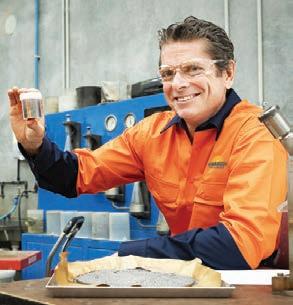
australianresourcesandinvestment.com.au ARAFURA RISES UP THE ASX RANKS ISSN 2201-9960 772201996000 04 HOW BHP EXPLORATIONEXPEDITES GREEN-METALINTRODUCINGETFS THE GOLDFOR 2023OUTLOOK VOLUME 17 NUMBER 1 | 2023 ResourcesAustralian&Investment LITHIUM HYDROXIDE Australia’s global opportunity Australian Resources & Investment is the country’s premier journal dedicated to providing cutting-edge insights into resource developments in Australia and around the world. Special feature articles include the best minds in the industry and examine investment, exploration and extraction, recruitment, engineering and mine management. Subscribe to Australian Resources & Investment to stay up to date with the latest news on ASX-listed mining stocks and commodity prices. AUSTRALIAN RESOURCES & INVESTMENT VOLUME 17 NUMBER 2 $14.95 incl. GST AUSTRALIA’S BRIGHT COPPER FUTURE ISSN 2201-9960 9 772201996000 04 NEW SHARK IN TOWN WHY GOLD CAN SHINE BRIGHTER IN 2023 HOW PILBARA MINERALS BUILT A LITHIUM EMPIRE VOLUME 17 NUMBER 2 | 2023 Australian Resources & Investment GRAPHITE’S TIME TO SHINE Charging up decarbonisation
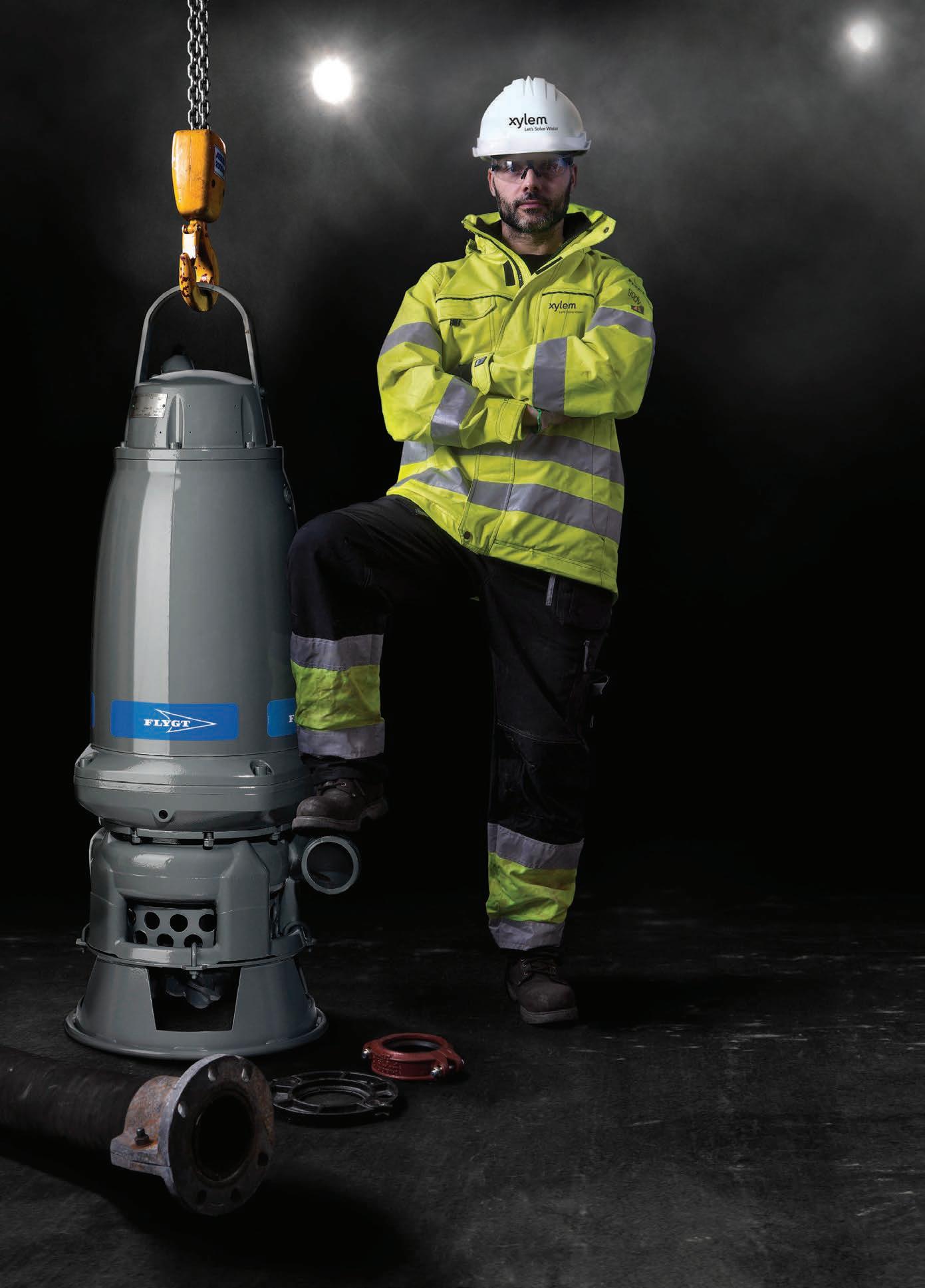





























 Aeris Resources’ Tritton copper operation in NSW.
Aeris Resources’ Tritton copper operation in NSW.














 Victor
Victor



































